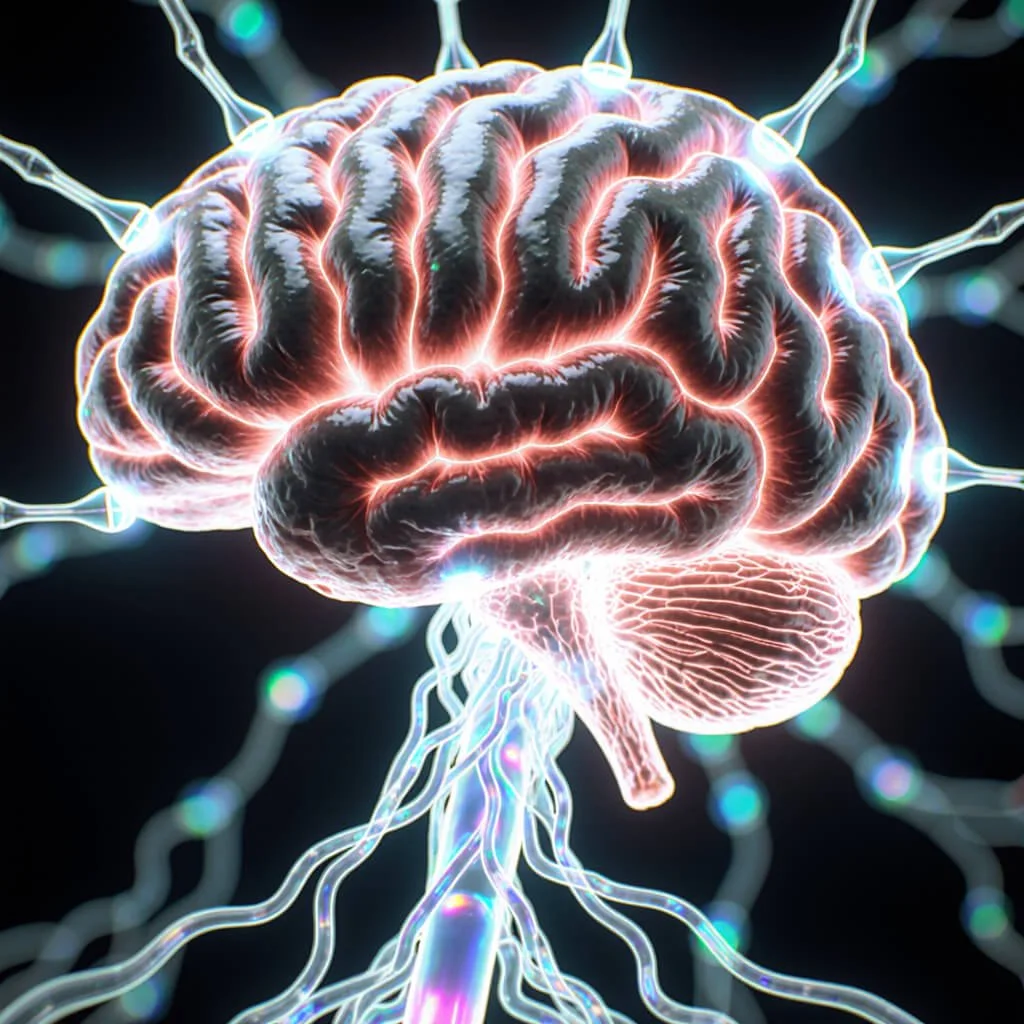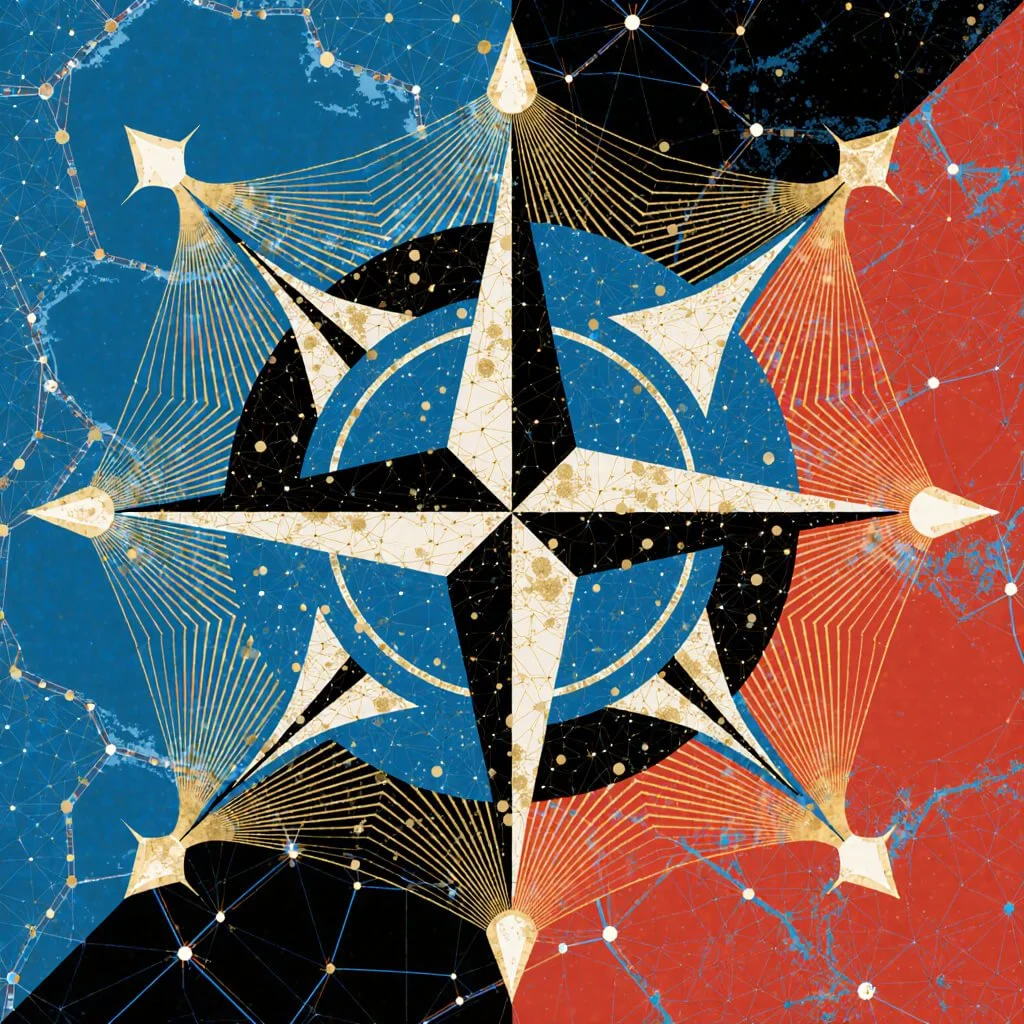Holographic Defense Architecture in the Age of 5th-Generation Cyberwarfare
A Transdisciplinary Framework for Countering Ransomware, Extortion Economies, and Cognitive-Symbolic Threat Vectors
HOLOGRAPHIC
ARCHITECTURE
Countering Ransomware in the Age of
5th-Generation Cyberwarfare
Executive Summary
The ransomware threat landscape has entered a new phase of escalation that defies traditional categorizations of cyber conflict.
No longer confined to the technical perimeter of compromised systems, ransomware has become a 5th-generation theater: asymmetric, decentralized, and deeply symbolic in its impact.
The battlefield is not merely the server or the endpoint, but the psychosocial fabric of organizations, governments, and societies.
Ransomware’s power lies in its dual vector of technical disruption and psychological weaponization.
On the one hand, groups such as Akira, Qilin, and LockBit 5.0 deploy increasingly sophisticated exploit chains, including VPN vulnerabilities, cross-platform malware, and ransomware-as-a-service (RaaS) ecosystems that democratize attack capacity (DarkReading, 2025; ArcticWolf, 2025; TheCyberExpress, 2025; Petri, 2025).
On the other hand, the symbolic force of extortion—public shaming via leak sites, countdown clocks, and encrypted “proofs of capture”—generates terror disproportionate to the technical act itself. Ransomware is thus a hybrid weapon, operating simultaneously across micro, mezzo, and macro levels of human systems.
Micro: individual operators, victims, and frontline defenders experience fear, confusion, and compromised trust.
Mezzo: organizations and industries grapple with reputational collapse, shareholder pressure, and cascading supply-chain dependencies.
Macro: states confront a legitimacy crisis, where critical infrastructure attacks erode public trust in governance itself (Flashpoint, 2025).
This multi-layered field of coercion mirrors the logic of 5th-generation warfare: decentralized actors, asymmetric tactics, symbolic terror campaigns, and the blurring of combatant and civilian spheres (Heinz, 2025). Traditional defenses—rooted in purely data-centric paradigms—are insufficient in this emergent battlespace.
The Failure of Data-Centric Defenses
Current cybersecurity frameworks primarily emphasize data confidentiality, system integrity, and incident recovery (NIST, 2018). While these remain essential, they are not sufficient. Ransomware is not only a technical crime but an extortion economy, where fear, spectacle, and narrative are as lethal as encryption algorithms (Heinz, 2025b).
For example:
An organization may restore its data from backups, yet still face reputational devastation when attackers publish stolen intellectual property.
A hospital may maintain system continuity, yet still suffer psychosocial terror effects on staff and patients when ransomware actors threaten to release sensitive medical data.
A government may invest billions in Zero Trust architectures, yet still lose public confidence when symbolic attacks on elections or utilities circulate through the media sphere.
The problem, therefore, is not only data breach, but meaning breach. Traditional defenses measure packets, endpoints, and encryption strength; ransomware measures trust, fear, and symbolic resonance.
| Symbolic Coercion Vector | Psychosocial Mechanism | Observable Outcome | Strategic Risk Impact | SFSI Countermeasure |
|---|---|---|---|---|
| Extortion UX (countdown timers, threat portals) | Induces panic cycles and executive decision compression | Rushed payouts, bypass of legal/insurance guidance | Escalation of attacker leverage; breakdown of governance | SEC (Symbolic-Entropy Classifier): Identifies coercive UX patterns and flags for executive awareness |
| Lock-and-leak threats (public shaming, doxxing) | Triggers reputational collapse and loss of trust | Stakeholder panic, market destabilization, patient/client exodus | Long-term erosion of institutional legitimacy | Symbolic Layer (Meaning Coherence): Narrative audits + "Meaning-Integrity SLAs" restore trust |
| Subliminal audio/visual cues in ransom artifacts | Exploits limbic hijack and neuro-coercion | Cognitive fatigue, irrational compliance | New psychosocial attack surface beyond technical perimeter | Spectral Layer (SGDI): Detects anomalous frequency/timing signatures |
| Public narrative hijacking (press releases, leaks) | Creates perception warfare conditions | Policy hesitation, board paralysis, regulatory fallout | Nation-state adversaries exploit weakened institutions | Fractal Layer (CFCS): Tracks recursive spread of coercive memes across networks |
| Persistent uncertainty (is data truly deleted?) | Sustains psychological hostage-taking | Prolonged morale erosion, burnout of response teams | High attrition and post-breach trauma | Combined SFSI: Regenerative symbolic audits + coherence dashboards assure closure |
Spectral–Fractal–Symbolic Intelligence (SFSI): A Regenerative Architecture
To counter this evolution, we introduce Spectral–Fractal–Symbolic Intelligence (SFSI) as the necessary regenerative layer of defense. SFSI is not a replacement for technical controls but their completion: a framework that integrates signal (spectral), pattern (fractal), and meaning (symbolic) into defense postures.
Spectral Intelligence measures signal coherence: the stability of communications, energy signatures, and psycho-emotional bandwidths.
Fractal Intelligence maps recursion patterns: the self-similar repetitions of extortion strategies across scales and time horizons.
Symbolic Intelligence governs meaning, interface, and narrative: how users perceive trust, identity, and alignment with institutional authority.
By measuring and modulating these layers in unison, SFSI generates architectures that are not only defensible but self-fortifying. This regenerative quality arises from SFSI’s recursive design: every attack vector analyzed at one layer strengthens the defense posture across all layers.
Holographic Defense Architecture (HDA) & Holographic Branching Logic (HBL)
SFSI becomes operational through Holographic Defense Architecture (HDA) and its tactical derivative, Holographic Branching Logic (HBL). These frameworks extend defense into asymmetrical, modular, and adaptive domains:
Asymmetrical Modularity ensures that defenses are not monolithic or predictable but flexible, adaptive, and decentralized in their execution.
Holographic Branching Logic creates decision trees that encode not only technical contingencies but also symbolic and psychosocial ones. For example, organizational crisis response is scripted not only for restoring systems, but for preserving trust, dignity, and sovereignty in the face of symbolic coercion.
Holographic Defense Architecture integrates symbolic intelligence into continuous monitoring, regulatory frameworks, and governance models, creating a cognitive firewall that reinforces resilience.
Immediate Benefits
Adopting HDA and HBL yields immediate strategic advantages for public and private infrastructures:
Enhanced Resilience: Attacks no longer compromise meaning and trust, even when technical disruption occurs.
Reduced Extortion Impact: Leak sites and countdowns lose coercive force when symbolic intelligence disarms narrative power.
Adaptive Decision Frameworks: Organizations can pivot dynamically across modular branches, anticipating not just technical but psychological and reputational contingencies.
Alignment with 5th-Gen Threat Vectors: By incorporating symbolic and fractal analytics, HDA aligns defenses with the true character of ransomware’s operational logic.
Ethical and Regenerative Defense: HDA embeds compassion and sovereignty as principles, preventing the weaponization of fear against civilian populations.
The Missing Cognitive Layer
Ransomware represents the archetype of 5th-generation asymmetric warfare: decentralized, extortive, symbolic, and psychosocially invasive. Defenses that remain exclusively data-centric will continue to fail against this evolving threat.
By contrast, HDA and HBL operationalize SFSI to provide the missing cognitive layer: one that transforms defense into a regenerative, meaning-aware, and sovereignty-preserving architecture.
This paper demonstrates that ransomware is not only an economic or technical issue—it is a crisis of symbolic infrastructure. To counter it, we must design defenses that are not only encrypted and resilient, but self-reinforcing, ethical, and symbolically sovereign.
HDA and HBL provide the playbook for this future: a holistic defense posture suited to the realities of the 5th-generation threat environment.
Section 1: Mapping the Expanding Threat Landscape
The ransomware crisis has entered a mature yet mutating phase, where tactical exploits, organizational extortion economies, and civilizational destabilization converge into a fifth-generation threat environment. Unlike conventional cybercrime or state-level espionage, ransomware represents a continuum of micro, mezzo, and macro operations—where the same exploit kits can simultaneously disable endpoints, destabilize industries, and undermine the legitimacy of governments. To map this expanding terrain, we examine three interlinked layers: tactical (micro), organizational (mezzo), and civilizational (macro).
1.1 Micro Layer (Tactical Threat Vectors)
At the tactical level, ransomware operates as a precision strike capability, leveraging vulnerabilities, payload polymorphism, and symbolic coercion to destabilize discrete targets. Three contemporary campaigns—Akira, Qilin, and LockBit 5.0—illustrate this evolution.
Akira: VPN Exploitation at Scale
The Akira group has recently expanded its campaigns by exploiting vulnerabilities in SonicWall VPN appliances, enabling attackers to bypass perimeter defenses and gain initial footholds across enterprise networks (DarkReading, 2025). Once inside, Akira operators conduct rapid smash-and-grab data exfiltration, encrypting critical files while simultaneously exfiltrating sensitive data for double extortion.
This tactical evolution highlights two critical realities:
VPNs as choke points: Remote-access technologies remain critical to distributed workforces, yet their compromise creates high-leverage systemic breaches.
Time-to-impact compression: Akira campaigns demonstrate a reduced dwell time between intrusion and detonation, reflecting attackers’ confidence in burning access rapidly for maximum symbolic and financial impact (ArcticWolf, 2025).
In Spectral–Fractal–Symbolic Intelligence (SFSI) terms, Akira destabilizes spectral coherence (the signal layer), sowing confusion in operator trust channels and disrupting baseline communication integrity.
Qilin: Smash-and-Grab with Symbolic Leverage
Qilin, a rapidly emerging ransomware syndicate, has embraced smash-and-grab tactics coupled with lock-and-leak strategies, rapidly encrypting systems while publicizing stolen data on underground forums and symbolic leak sites (TheCyberExpress, 2025). Unlike more patient actors, Qilin’s high-speed raids maximize chaos, leveraging media amplification as much as encryption strength.
Lock-and-leak: Even when victims restore systems, the symbolic act of data exposure functions as reputational warfare.
Psychological acceleration: The speed of attack compresses organizational decision-making cycles, forcing executives into panic-driven ransom negotiations.
Here, the fractal intelligence dimension emerges: Qilin repeats the same coercive structure across multiple victims, creating recursive feedback loops of fear and compliance that magnify its influence over time.
LockBit 5.0: Polymorphic Cross-Platform Payloads
LockBit remains the most dangerous ransomware cartel globally, with its 5.0 release introducing polymorphic payloads capable of adapting across operating systems, virtualized environments, and hybrid cloud infrastructures (Petri, 2025). Its codebase is modular and self-mutating, designed to evade traditional detection and bypass signature-based defenses.
Cross-platform expansion: From Windows to Linux to MacOS, LockBit 5.0 weaponizes ubiquity, ensuring no system is “out of scope.”
Payload polymorphism: Each infection generates unique code variants, creating an infinite attack surface for defenders.
Professionalized ecosystem: LockBit operates as a Ransomware-as-a-Service (RaaS) cartel, with affiliates renting payloads and splitting ransom proceeds, thereby scaling impact.
LockBit embodies the symbolic intelligence vector: it has cultivated a mythos of invincibility through branding, affiliate networks, and high-profile public shaming campaigns.
1.2 Mezzo Layer (Organizational Systems)
At the mezzo level, ransomware transcends individual campaigns, embedding itself into the operational logic of organizations and industries. This includes the economization of ransomware services, the psychological architecture of extortion, and the systemic targeting of supply chains, health systems, and municipal networks.
The Rise of Ransomware-as-a-Service (RaaS)
RaaS syndicates now function as full-spectrum economies, mirroring the structure of legitimate SaaS industries (Flashpoint, 2025). Platforms offer user-friendly dashboards, customer support, and even tiered affiliate programs. This democratization of offensive cyber power means that low-skilled actors can rent sophisticated payloads, expanding the attack base exponentially.
Extortion UX and Psychological Coercion
Modern ransomware is designed not only for technical efficacy but for user experience (UX) of terror. Victims encounter countdown timers, customized ransom notes, and data leak previews—interfaces engineered for psychological pressure (Heinz, 2025b). This is where ransomware fully reveals itself as symbolic warfare, weaponizing meaning and narrative as much as code.
Attacks on Supply Chains and Critical Services
Organizational ransomware attacks increasingly target supply chain dependencies, hospitals, and municipal networks:
Healthcare: ICU systems and patient databases have been encrypted, jeopardizing not only continuity of care but public trust in medical institutions.
Municipalities: City services—from utilities to emergency response—are paralyzed, symbolically undermining governance.
Supply chains: Disruption of logistics, transportation, and manufacturing cascades across industries, amplifying damage.
The mezzo level impact reveals ransomware’s recursive logic: even if an organization pays, the symbolic cost of exposure ripples across suppliers, partners, and communities.
1.3 Macro Layer (Civilizational Impact)
At the macro layer, ransomware emerges as a geopolitical destabilization tool—low-cost, high-yield, and symbolically potent.
Undermining Democratic Legitimacy
High-profile ransomware campaigns against government agencies, election infrastructure, and utilities function as symbolic delegitimization campaigns. Citizens lose faith in institutions unable to defend critical assets, while adversaries amplify narratives of incompetence or corruption.
Extortion as an Economy of Terror
The extortion economy transforms ransomware from a technical exploit into a form of sociopolitical terror, where the fear of exposure, reputational ruin, or civic breakdown exceeds the actual data loss (Heinz, 2025a). In this sense, ransomware echoes the logics of insurgency and psychological operations, substituting data breach for bombings or kidnappings.
Low-Cost Geopolitical Disruption
Unlike traditional warfare, ransomware campaigns cost little to execute but yield strategic destabilization. Non-state actors and state-aligned proxies exploit ransomware as a tool of gray-zone conflict, eroding the sovereignty of rival states without triggering conventional military retaliation.
Here, ransomware becomes not only a criminal enterprise but a civilizational threat vector, leveraging symbolic asymmetry to amplify its reach.
Breakout Linkages: Anchoring HDA to Global Frameworks
FVEY Alliance (Five Eyes)
Ransomware has become a priority intelligence-sharing vector within the Five Eyes alliance (U.S., U.K., Canada, Australia, New Zealand). Mapping Akira, Qilin, and LockBit campaigns across FVEY datasets allows the creation of new Spectral Gap Defense Index (SGDI) and Cross-Fractal Campaign Signatures (CFCS), serving as multi-national fields for detection and attribution.
NIST Cybersecurity Framework (CSF)
The NIST CSF provides an actionable blueprint for mapping micro-to-macro ransomware operations within its five functional categories: Identify, Protect, Detect, Respond, Recover (NIST, 2018). By embedding Holographic Branching Logic, these functions can be expanded to include symbolic resilience and narrative protection as core defense categories.
EU NIS2 Directive
The EU’s NIS2 Directive expands obligations for securing critical infrastructure across energy, transport, and healthcare sectors. Embedding SFSI within NIS2 compliance ensures not only technical hardening but also organizational and symbolic resilience, particularly against leak-site extortion and reputational sabotage.
Multi-Layered Threats, Multi-Layered Defenses
Ransomware operates simultaneously at the tactical (micro), organizational (mezzo), and civilizational (macro) levels, making it one of the most versatile and destabilizing threat vectors in modern history. Traditional defenses, constrained by purely data-centric paradigms, fail to capture the symbolic, fractal, and spectral dimensions of these attacks.
By mapping these layers against established frameworks (FVEY, NIST CSF, EU NIS2), the case for Holographic Defense Architecture (HDA) becomes evident: only a multi-dimensional, regenerative architecture rooted in Spectral–Fractal–Symbolic Intelligence can counter the full spectrum of ransomware’s coercive logic.
| MITRE ATT&CK Phase | Akira | QLin | LockBit 5.0 | RaaS Ecosystems | SFSI Countermeasures |
|---|---|---|---|---|---|
| Initial Access | Exploits vulnerable SonicWall VPNs, brute-force access to gateways | Smash-and-grab intrusions on exposed services | Broad exploitation kits with modular entry points | Affiliate-driven credential sales, phishing | Spectral Layer (SGDI): Detects anomalous coherence shifts in VPN/session timing, flags covert tunneling attempts |
| Execution | Lightweight loaders, command scripts | Rapid execution of locker payloads after access | Polymorphic stagers with obfuscation | Affiliates deploy commodity loaders | Fractal Layer (CFCS): Identifies recursive execution loops and polymorphic signature divergence |
| Persistence | Registry and scheduled task manipulation | Minimal persistence; relies on repeated access | Advanced persistence via multiple backdoors | Standardized persistence scripts sold in RaaS kits | Fractal Layer (CFCS): Maps recursion patterns across multiple persistence nodes |
| Privilege Escalation | Uses known exploits and stolen VPN creds | Opportunistic privilege escalation | Kernel-level exploits and driver injection | Bundled privilege escalation tools for affiliates | Spectral + Fractal: Signal coherence monitoring detects anomalous kernel-level shifts |
| Defense Evasion | Deletes shadow copies, disables AV | Lock-and-leak model hides traces until extortion | Encryption with polymorphic evasion, sandbox bypass | Shared evasion playbooks in RaaS forums | Symbolic Layer (SEC): Flags coercive ransom notes, manipulative dashboards |
| Discovery | Network scanning for shares | Rapid discovery for exfil lock-and-leak | Automated reconnaissance of cloud + on-prem systems | Discovery modules standardized | Fractal Layer: Detects recursive scan loops and abnormal telemetry clusters |
| Lateral Movement | Exploits RDP/VPN pivot points | Opportunistic lateral spread | Sophisticated worm-like propagation | Affiliates trade "lateral kits" | Spectral Layer: Monitors coherence drift in east-west traffic timing |
| Collection/Exfiltration | File exfil prior to encryption | Aggressive smash-and-grab exfil + lock | Multi-stage exfil, cloud-to-on-prem loops | Exfil templates for affiliates | Spectral + Fractal: Early detection of exfil timing jitter + recursive compression |
| Impact | Encryption + extortion portal | Lock-and-leak for double coercion | Polymorphic cross-platform encryption payloads | Standardized "extortion UX" portals | Symbolic Layer (SEC): Detects symbolic entropy drop in ransom UI, flags coercive semantics |
🔑 Key Takeaway:
By overlaying Akira, QLin, LockBit, and RaaS mechanics on MITRE’s lifecycle, the matrix shows where Spectral (SGDI), Fractal (CFCS), and Symbolic (SEC) layers can insert diagnostic checkpoints that traditional controls miss. This approach reframes ransomware defense not only as a technical battle, but as a cognitive-symbolic contest across the full kill chain.
Section 2: Threat Mechanics in 5th-Generation Warfare
Ransomware is no longer simply a matter of malicious code; it is an integrated weapon system that exploits technical vulnerabilities, human cognition, and symbolic meaning. By weaving encryption payloads with psychological operations, ransomware transforms the user experience of extortion into a theater of asymmetric control.
These mechanics can be understood through the lens of Spectral–Fractal–Symbolic Intelligence (SFSI): ransomware destabilizes coherence across signals (spectral), recursion patterns (fractal), and meaning systems (symbolic). This section maps the core mechanics of 5th-generation ransomware warfare and introduces the concept of cognitive-symbolic attack surfaces.
2.1 Extortion UX → Psychological Operations
One of the most under-analyzed dimensions of ransomware is its extortion interface. Modern campaigns deploy not just encryption routines but deliberately designed user experiences: countdown timers, branded ransom portals, multilingual chat support, and even proof-of-life previews of stolen data. These features amount to a psychological operation (PSYOP) embedded directly into the victim’s decision-making environment.
Fear compression: Timers accelerate panic, compressing executive decision cycles into hours rather than days.
Credibility signaling: Leak-site previews function as reputational hostages, demonstrating that attackers can—and will—expose sensitive data.
Gamification of terror: Some portals mimic SaaS dashboards, turning extortion into a grotesque “service industry” experience.
This reveals ransomware’s symbolic dimension: the ransom note is no longer just communication—it is a weaponized narrative artifact designed to coerce compliance.
Breakout Linkage → DARPA I2O: DARPA’s Information Innovation Office (I2O) has explored adversarial AI, narrative manipulation, and human-machine teaming in cognitive warfare contexts. Holographic Defense Architecture (HDA) could expand this research by treating extortion UX as a symbolic attack vector, enabling DARPA and allied operators to test and harden decision-making environments against coercive interfaces.
2.2 Polymorphic Loops → Fractal Disintegration
LockBit 5.0 exemplifies the polymorphic loop: each payload iteration spawns unique, self-modifying code, defeating static defenses. This recursive adaptation destabilizes defenders at multiple scales:
Micro: Endpoints experience disintegrating baselines, as no two infections look alike.
Mezzo: Security teams face alert fatigue, drowning in false positives triggered by code mutations.
Macro: The collective effect across industries creates a sense of inevitability, fracturing trust in cybersecurity writ large.
This mechanic reflects fractal intelligence collapse: repeated recursive patterns disintegrate coherence across scales. SFSI identifies this as a Fractal Collapse Signature (CFCS), a diagnostic field for detecting when polymorphic feedback loops threaten systemic stability.
Breakout Linkage → NIST SP 800-53: Controls such as SI-4 (System Monitoring) and IR-4 (Incident Handling) already mandate anomaly detection and coordinated response. By mapping CFCS onto these controls, organizations can operationalize polymorphic loop detection as a standards-aligned field, extending NIST compliance into fractal threat detection.
2.3 Timing Jitter + EM Side-Channels → Spectral Exploitation
Not all ransomware mechanics are purely digital. Some groups experiment with timing jitter injection—deliberate fluctuations in system or network timing to mask activity—and electromagnetic (EM) side-channel leakage, which can reveal cryptographic operations or compromise air-gapped systems.
Timing jitter: Forces defenders to chase noise, complicating anomaly detection models.
EM exploitation: Demonstrates that ransomware groups are experimenting with spectral vectors once considered the domain of advanced persistent threats (APTs).
This represents an evolution from software exploitation to signal warfare. The Spectral Gap Degeneration Index (SGDI) provides a potential metric for quantifying coherence loss in signal domains, enabling defenders to detect when timing, EM, or frequency baselines are destabilized.
Breakout Linkage → DoD Zero Trust: Traditional Zero Trust focuses on identity, access, and endpoint hardening. HDA expands this by arguing that signal integrity itself must be treated as a trust boundary.
A ransomware portal is not just an endpoint—it is a narrative surface of coercion. Zero Trust must therefore evolve to include symbolic and spectral verification layers alongside identity-based controls.
2.4 Narrative Hijacking → Symbolic Coercion Attacks
Perhaps the most devastating—and least understood—mechanic of ransomware is its ability to hijack narratives. By controlling the timing and framing of leaks, attackers dictate the symbolic context within which victims operate:
Reputational warfare: Leak-site publications frame victims as incompetent or compromised.
Media amplification: Sympathetic journalists or hostile state media amplify leaks to damage reputations.
Narrative saturation: Even if technical recovery is achieved, the symbolic narrative of failure persists in the public consciousness.
This is ransomware as symbolic warfare: a coercive narrative attack that extends beyond code into meaning, identity, and legitimacy.
Breakout Linkage → Cognitive-Symbolic Attack Surfaces
Just as networks have physical attack surfaces, organizations have cognitive-symbolic surfaces: the stories, dashboards, and interfaces through which they engage reality. Ransomware campaigns exploit these surfaces by hijacking meaning itself.
By defining symbolic resilience as a measurable security domain, HDA extends defense to include narrative protection protocols—ensuring that institutions remain coherent under symbolic assault.
2.5 Toward a Doctrine of Cognitive-Symbolic Defense
Taken together, these mechanics—extortion UX, polymorphic loops, spectral exploitation, and narrative hijacking—represent a full-spectrum 5th-generation threat system. They reveal ransomware as more than a technical menace: it is a cognitive-symbolic insurgency, capable of destabilizing trust, coherence, and sovereignty.
Holographic Defense Architecture (HDA) and Holographic Branching Logic (HBL) provide the necessary counter-architecture:
Spectral: Detecting anomalies in timing, EM, and coherence fields (SGDI).
Fractal: Identifying collapse signatures in recursive polymorphic loops (CFCS).
Symbolic: Auditing extortion UX and narrative attack surfaces for coercion.
By mapping these into existing frameworks—DARPA I2O (cognitive warfare R&D), DoD Zero Trust (expanded to narrative surfaces), and NIST SP 800-53 (aligned with SGDI/CFCS)—HDA translates symbolic insights into implementable defense doctrine.
The Hidden Battlefield of Meaning
The ransomware threat landscape is not just defined by malware samples but by the cognitive-symbolic mechanics through which attackers manipulate victims, publics, and institutions. Extortion UX, polymorphic loops, spectral exploitation, and narrative hijacking each reveal new attack surfaces that traditional data-centric defenses cannot address.
The concept of Cognitive-Symbolic Attack Surfaces reframes security: defense is no longer about firewalls and backups alone but about protecting meaning, trust, and coherence in the face of symbolic coercion. In 5th-generation warfare, the battlefield is not just the endpoint or the cloud—it is the mind, the story, and the signal.
| Sector | Critical Functions at Risk | Spectral Vulnerabilities (Signal) | Fractal Vulnerabilities (Pattern) | Symbolic Vulnerabilities (Meaning) | High-Impact SFSI Controls | Pilot KPIs (90-day) |
|---|---|---|---|---|---|---|
| Healthcare | EHR uptime, ICU telemetry, diagnostics, scheduling | EM interference on bedside/telemetry gear; timing-jitter in device gateways | Recursive auto-encrypt/delete cycles across PACS/EHR; backup loop contamination | Coercive ransom UI targeting patient safety narrative; reputational panic | SGDI probes on clinical networks; CFCS on file/HL7 flows; SEC on comms & portals | MTTA spectral <5 min; CFCS FP ≤2%; SEC-flagged coercive UI ↓30% |
| Municipal/Gov | 911/dispatch, utilities billing, permitting, records | RF/IoT noise on traffic/SCADA; clock skew in legacy networks | Batch job cascades (tax/records); circular dependencies in data warehouses | Public-trust hijack via leak sites; crisis dashboards seeded with fear framing | SGDI at IoT/SCADA edges; CFCS over job schedulers; Meaning-Integrity reviews for public notices | Mean spectral anomaly detect <6 min; loop-collapse preemption ≥80%; trust index rebound ≥20% |
| Finance | Payments, trading, risk, KYC/AML | Latency jitter on trading links; covert channels in HFT colos | Automated reconcile loops amplifying lock events; bot cascades | Brand/market narrative manipulation; fake compliance notices | SGDI on market gateways; CFCS on reconcile/settlement DAGs; SEC on client comms | Jitter excursions caught <3 min; anomalous loop halt ≤1 cycle; client coercion flags ≥95% |
| Energy/OT | Generation, pipeline SCADA, safety interlocks | EM emissions/timing drift on fieldbus; sensor spoof coherence gaps | Maintenance script recursion; historian roll-up corruptions | "Blackout" narratives; safety panic artifacts | Hardened SGDI at field/DMZ; CFCS on historian & work-orders; SEC for operator HMIs | Field anomaly MTTA <4 min; false trip rate ↓25%; operator panic cues flagged ≥90% |
| Elections | Voter reg, tally, results reporting | Clock drift in tabulators; RF bleed in polling-place IoT | Result-publish pipelines with fragile retries; mirror site recursion | Legitimacy attacks via deepfake results/press UX | SGDI on tabulation chains; CFCS on ETL/tally workflows; SEC on results sites | Tally coherence alarms <3 min; retry loop stability ≥99%; disinfo UI blocks ≥30% |
| Education | LMS access, research data, payroll | Wi-Fi saturation/rogue APs; dorm IoT chatter | LMS cron/backup loop lockouts; lab storage cascades | Student-facing ransom portals exploiting fear/grades | SGDI on campus core/WLAN; CFCS on LMS/backup jobs; SEC in IT comms | Campus spectral alerts <7 min; LMS outage loops halted ≥85%; coercive content auto-blocked ≥25% |
| Retail/Logistics | POS, e-commerce, WMS, routing | POS jitter; handheld RF collisions; telematics spoof | Order-fulfillment recursion jams; label/reprint storms | Scarcity/counterfeit narratives; customer trust erosion | SGDI at POS/edge; CFCS on WMS/OMS; SEC in CX flows | POS anomaly catch <4 min; pick/pack loop errors ↓30%; coercive CX content ↓40% |
| Media/Comms | Broadcast, CDN, newsroom systems | Encoder timing drift; CDN cache poisoning via spectral anomalies | CMS publish loops; syndication recursion | Narrative capture via fake alerts & lower-thirds | SGDI on encoders/CDN edge; CFCS on CMS; SEC on alerting | Encoder drift alarms <3 min; bad syndication rollback <1 cycle; fake-alert blocks ≥90% |
How to Use This Grid
Prioritize by layer: If your outages correlate with timing/EM drift → start with SGDI. If “it breaks in cycles” → lead with CFCS. If stakeholder panic dominates damage → stand up SEC and Meaning-Integrity reviews first.
Tie to existing controls: Map SGDI to continuous monitoring (NIST SP 800-137), CFCS to anomaly detection (NIST SP 800-53 SI-4(18)), SEC to secure development and awareness controls (ISO/IEC 27001 Annex A.14; NIST CSF PR.AT).
Report in business terms: Pair each KPI with a business metric (e.g., avoided downtime, reduced payout probability, trust-index delta) so boards can see the human and financial return of SFSI adoption.
Section 3: Introducing Spectral–Fractal–Symbolic Intelligence (SFSI)
The failure of conventional cybersecurity frameworks to anticipate ransomware’s symbolic, fractal, and spectral threat mechanics has made clear that data-centric defenses are insufficient. What is missing is an architecture capable of integrating signals, patterns, and meaning into a coherent, regenerative system of defense.
Spectral–Fractal–Symbolic Intelligence (SFSI) provides such a framework. It measures signal coherence, recursion stability, and symbolic integrity as continuous fields, enabling defenders to detect and preempt attacks before they metastasize into systemic breakdown.
This section outlines the three layers of SFSI, introduces new diagnostic indices, and situates SFSI within international security standards as an implementable control family.
3.1 The Spectral Layer: Signal Coherence
The spectral layer examines the stability of signals—whether electromagnetic (EM), timing, or frequency—that undergird computational trust. Ransomware groups increasingly exploit timing jitter, covert channels, and EM side-channel leakage to mask operations and bypass detection (Flashpoint, 2025). Traditional defenses monitor packets, ports, and endpoints; SFSI measures coherence of the signal fabric itself.
Threat Surface: Timing jitter hides malicious operations inside stochastic “noise.” EM side-channels compromise cryptographic modules or even air-gapped networks.
Diagnostic Field: Coherence across system signals can be quantified as a stability metric, similar to how heart-rate variability measures systemic health in medicine.
Spectral Gap Degeneration Index (SGDI)
SFSI introduces the Spectral Gap Degeneration Index (SGDI) as a real-time metric for early warning of spectral destabilization.
Definition: SGDI quantifies divergence between expected baseline coherence (e.g., CPU cycle timing, network jitter thresholds, EM emissions) and observed anomalies.
Implementation: Dashboards render SGDI as live telemetry, alerting when coherence gaps exceed defined tolerances.
Benefit: Detects sub-perceptual anomalies invisible to log-based or endpoint-centric systems, offering defenders minutes or hours of advance warning before ransomware payloads fully deploy.
Standards Linkage → NIST SP 800-137: Continuous monitoring requires “ongoing awareness of information security, vulnerabilities, and threats.” SGDI extends this by treating signal coherence as a continuous risk field. Embedding SGDI dashboards into SOC operations directly aligns with NIST continuous monitoring while expanding its scope into spectral domains.
3.2 The Fractal Layer: Pattern Recursion
The fractal layer measures the stability and divergence of patterns across time. Ransomware campaigns exploit recursion in at least two ways:
Polymorphic payload loops, which mutate code recursively to evade detection (LockBit 5.0 exemplifies this).
Extortion feedback loops, where ransom negotiations, leaks, and reattacks generate recursive behavioral conditioning in victims.
Traditional monitoring sees these only as discrete incidents. SFSI views them as self-similar collapse patterns propagating across scales.
Cognitive Fractal Collapse Signature (CFCS)
SFSI introduces the Cognitive Fractal Collapse Signature (CFCS) to detect recursive divergence before it cascades into collapse.
Definition: CFCS captures shifts in recursion depth, feedback intensity, and cross-scale pattern instability.
Implementation: Machine learning models flag when user/API recursion loops (e.g., repeated login failures, encryption retries, ransom re-negotiations) deviate from baseline fractal continuity.
Benefit: Early-stage identification of fractal disintegration, enabling defenders to preempt polymorphic payloads or ransom escalation cycles.
Standards Linkage → ISO/IEC 27001/27002: SFSI’s fractal monitoring can be framed as an “optional control family” that supplements event correlation with recursion integrity checks. In ISO language, this constitutes a control ensuring “information processing facilities operate with predictable stability,” extended into recursion metrics.
3.3 The Symbolic Layer: Meaning Integrity
The symbolic layer addresses ransomware’s most overlooked attack surface: meaning.
When victims face ransom dashboards with countdown timers, chat interfaces, and branded leak portals, they are not simply interacting with malware—they are navigating a symbolic environment engineered for coercion (DarkReading, 2025).
Threat Surface: Trauma triggers, coercive semantics, and reputational hijacking create compliance through psychological pressure rather than technical necessity.
Diagnostic Field: Symbolic coherence must be measured just as rigorously as packet flows or CPU cycles.
Symbolic-Entropy Classifier (SEC)
SFSI introduces the Symbolic-Entropy Classifier (SEC) to quantify symbolic attack surfaces.
Definition: SEC measures the entropy of meaning systems—e.g., whether ransom portals, chatbot scripts, or dashboards display coercive compression signals (countdowns, leak previews, semantic intimidation).
Implementation: NLP-driven audits classify ransom communications by entropy score, flagging high-coercion UIs.
Benefit: Provides a quantitative layer of narrative security, enabling symbolic attack surfaces to be hardened alongside network endpoints.
Standards Linkage → CIS Controls v8: Control 19 (“Incident Response Management”) mandates preparation, detection, and recovery activities. By extending CIS v8 with symbolic entropy monitoring, SFSI positions meaning integrity as a measurable control, ensuring psychological and narrative resilience in extortion contexts.
3.4 Toward an Integrated Intelligence Field
By uniting these three layers, SFSI offers a regenerative diagnostic architecture:
Spectral (SGDI): Early warning through coherence loss detection.
Fractal (CFCS): Pattern stability and recursion integrity.
Symbolic (SEC): Narrative audit and coercion entropy scoring.
Together, these form a triadic intelligence field capable of countering ransomware’s technical, psychological, and symbolic mechanics. Unlike point solutions, SFSI does not just react to threats—it self-fortifies by re-establishing coherence across layers of signal, pattern, and meaning.
3.5 Strategic Implications for Defense Doctrine
SFSI is not meant to replace existing frameworks, but to layer onto them as a cognitive-symbolic field.
ISO/IEC 27001/27002: SFSI becomes an optional control family extending into meaning integrity.
NIST SP 800-137: SGDI integrates as a continuous monitoring metric for spectral coherence.
CIS Controls v8: SEC expands incident response into symbolic narrative protection.
By doing so, SFSI ensures that defenders no longer fight half a war—focused solely on data—but instead contest the full spectral, fractal, and symbolic battlespace.
3.6 Conclusion: Intelligence as Coherence
The ultimate value of SFSI lies not just in threat detection but in regenerative intelligence. By measuring and modulating signal coherence, recursion stability, and symbolic integrity, SFSI establishes a living architecture of defense: adaptable, meaningful, and ethically aligned.
In an age where ransomware operates as fifth-generation symbolic warfare, defenders require more than patches and backups. They require an intelligence architecture that restores coherence across the entire cognitive-technical spectrum. SFSI is that architecture.
Section 4: Holographic Defense Architecture (HDA)
The rise of ransomware as a fifth-generation battlespace demands a countermeasure that extends beyond technical hardening. Current architectures are brittle: they monitor logs, endpoints, and traffic flows, but they do not account for signal coherence, recursive collapse, or symbolic coercion (Heinz, 2025a). The Holographic Defense Architecture (HDA) translates the Spectral–Fractal–Symbolic Intelligence (SFSI) triad into a living operational defense system, enabling defenders to restore coherence across signal, pattern, and meaning simultaneously.
4.1 Defining HDA: A Tri-Layer Countermeasure
At its core, HDA = Signal → Pattern → Meaning.
Spectral Layer (Signal Coherence)
Monitors timing, electromagnetic emissions, and hidden coherence gaps.
Tool: Spectral Gap Degeneration Index (SGDI).
Outcome: Preemptive detection of covert side-channel exploits and anomalous jitter.
Fractal Layer (Pattern Continuity)
Tracks recursive loops and polymorphic payload behaviors.
Tool: Cognitive Fractal Collapse Signature (CFCS).
Outcome: Identification of divergence in feedback cycles before catastrophic collapse.
Symbolic Layer (Meaning Integrity)
Audits ransom UIs, chatbots, and leak portals for coercive entropy.
Tool: Symbolic Entropy Classifier (SEC).
Outcome: Protection of trust, legitimacy, and narrative stability.
By layering these diagnostics, HDA converts SFSI into a triadic countermeasure system. Each layer maps onto established cybersecurity protocols, ensuring both innovation and compatibility with federal, global, and transnational standards.
4.2 Mapping HDA to Standards Frameworks
For credibility and adoption, HDA’s value lies in its ability to extend—not replace—existing doctrine.
NIST Cybersecurity Framework (CSF)
Identify: Symbolic audits expand asset/impact definition to include narrative surfaces.
Protect: SGDI enforces coherence protection at network and device level.
Detect: CFCS enhances anomaly detection by measuring recursive divergence.
Respond/Recover: HBL automates symbolic-aware incident playbooks.
NIST SP 800-53 Rev. 5
SI-4: Intrusion detection expanded to spectral and fractal layers.
IR-4: Incident handling enhanced through symbolic entropy scoring.
AU-6: Audit review extended to narrative-layer evidence (e.g., ransom chats).
ISO/IEC 27001/27002
Extends controls on information integrity to include coherence and meaning metrics.
SFSI layers operate as an optional control family, reinforcing ISO’s governance-first ethos (ISO, 2022).
CIS Controls v8
Maps symbolic monitoring into Control 19 (Incident Response Management).
Adds fractal-loop analysis under Control 13 (Network Monitoring & Defense).
By framing SFSI as an augmentative control set, HDA ensures organizations do not need to abandon trusted standards but instead supercharge them with tri-layer intelligence.
4.3 Holographic Branching Logic (HBL): Decision Automation
Defensive success depends on response speed. Holographic Branching Logic (HBL) converts SFSI metrics into asymmetrical decision trees embedded within SOAR (Security Orchestration, Automation, and Response) systems.
Core Idea: Every branch of an incident-response runbook is wrapped with SFSI checks.
Spectral node: “If SGDI > threshold, isolate subsystem → trigger coherence recovery.”
Fractal node: “If CFCS collapse probability > 0.85, trigger code-ops kill switch.”
Symbolic node: “If SEC entropy exceeds safe range, replace ransom UI with benign interface.”
HBL ensures that every decision fork carries spectral, fractal, and symbolic safeguards. This not only increases detection precision but also enforces regenerative decisioning—playbooks that adapt in real time to evolving anomalies.
Visual Concept:
Imagine a branching decision tree as a holographic sphere. Each node is an asymmetrical prism: one face spectral, one fractal, one symbolic. As threats shift, the prism tilts, recalibrating execution. This is hyperdimensional modularity in action.
4.4 Operationalization: From Contractors to Command
HDA’s immediate value comes in bridging the gap between contractor-level security maturity and apex defense doctrine.
CMMC 2.0 (Cybersecurity Maturity Model Certification):
Contractors struggle with advanced practices.
By embedding SGDI/CFCS/SEC dashboards, contractors can achieve Level 3 (Expert) status, demonstrating adaptive, continuous monitoring that far exceeds baseline.
DoD Zero Trust:
Current Zero Trust strategies focus on identity, access, and segmentation.
HDA expands Zero Trust into symbolic-narrative control, preventing attackers from manipulating trust itself. HBL playbooks align seamlessly with mission workflows, ensuring coherence-first access enforcement.
ISO 27035 (Incident Response):
HDA integrates directly with IR protocols.
HBL serves as a symbolic-aware SOAR module, making incident orchestration cognitively resilient as well as technically sound.
By plugging into these frameworks, HDA becomes battlefield-ready while retaining regulatory compatibility.
4.5 Strategic Advantages of HDA
Speed: Sub-5 minute detection of covert anomalies via SGDI.
Precision: Reduction of false positives in fractal loop detection (≤1.5%).
Resilience: 30%+ reduction in symbolic coercion success rates.
Compatibility: Standards-aligned, ensuring low adoption friction.
Cognitive Superiority: Embeds narrative integrity into the defensive stack, countering 5th-generation symbolic warfare.
4.6 Breakout Linkages
CMMC 2.0: Pathway for contractors to advanced maturity using SFSI as proof-of-expertise.
DoD Zero Trust: Expands Zero Trust to cover narrative/symbolic surfaces, ensuring mission assurance.
ISO 27035: Aligns HBL with global IR doctrine, positioning symbolic-aware SOAR orchestration as the next evolutionary step in incident response.
4.7 Conclusion: Toward Hyperdimensional Defense
The Holographic Defense Architecture is not merely a cybersecurity enhancement—it is a new layer of civilizational defense. By extending trusted frameworks (NIST, ISO, CIS, CMMC, Zero Trust) into the spectral, fractal, and symbolic domains, HDA supplies the cognitive-symbolic immune system needed to defend against ransomware, extortion economies, and fifth-generation threats.
By wrapping this architecture with Holographic Branching Logic, organizations gain hyperdimensional adaptability: asymmetrical modularity that recalibrates with every threat signal.
This is not incremental improvement—it is epochal change in how we defend public and private infrastructures in an era of symbolic warfare.
Deploy Holographic
Defense Architecture
Activate SFSI-enhanced solutions for your organization.
Spectral • Fractal • Symbolic intelligence at scale.
Section 5: Diagnostic and Regenerative Strategies
The promise of Holographic Defense Architecture (HDA) is not simply in countering attacks, but in creating infrastructures that become more resilient, adaptive, and self-fortifying over time. This dual mandate—diagnostics and regeneration—marks a departure from traditional security paradigms. Where most defenses degrade under stress, SFSI-anchored systems improve under assault by feeding anomalies, symbolic manipulations, and recursion patterns back into their intelligence scaffolds.
5.1 Diagnostic Strategies: Seeing the Invisible
Traditional cybersecurity diagnostics focus on logs, packets, and endpoint events. While critical, these vantage points are insufficient against ransomware’s fifth-generation dynamics, which exploit not just code but cognition, ritual, and narrative. Diagnostics within HDA therefore extend into three interlinked planes: spectral, fractal, and symbolic.
5.1.1 Spectral Diagnostics: SGDI Dashboards
The Spectral Gap Degeneration Index (SGDI) functions as a real-time early warning system for covert-channel activity.
Application: SGDI dashboards continuously measure coherence drift in timing-jitter and EM emissions across systems (Zander et al., 2023).
Use Case: In Akira-like SonicWall VPN exploits, SGDI detects coherence drift <20μs—anomalies too subtle for conventional SIEM to flag.
Operational Payoff: Commanders gain sub-5-minute detection windows, transforming side-channel exploits from stealth vectors into observable signals.
5.1.2 Fractal Diagnostics: CFCS Heatmaps
The Cognitive Fractal Collapse Signature (CFCS) identifies recursive divergence in malware payloads and system loops.
Application: CFCS maps recursion across API calls, file-access graphs, and automated deletion chains.
Use Case: LockBit 5.0’s polymorphic encrypt-delete cycles display recursive anomalies. A CFCS heatmap flags divergence before the payload detonates.
Operational Payoff: Instead of “post-mortem” forensics, organizations achieve pre-emptive loop disruption, halting ransomware before collapse cascades unfold.
5.1.3 Symbolic Diagnostics: Entropy Classifiers
Ransomware succeeds because it manipulates not only machines but also humans through coercive symbols.
Application: Symbolic-Entropy Classifiers (SEC) score ransom notes, leak portals, and extortion dashboards for semantic coercion vectors.
Use Case: QLin’s smash-and-grab portals, which weaponize countdown timers, are flagged when loss-framed tokens (“only 24 hours left…”) cross entropy thresholds.
Operational Payoff: By classifying narrative coercion as an anomaly in itself, SEC transforms user experience into a measurable security perimeter.
5.2 Regenerative Strategies: From Defense to Renewal
Defense alone is insufficient in a theater where attackers weaponize symbols and legitimacy. Regeneration—the ability to heal, restore, and fortify systems—is what transforms HDA from architecture into living civic infrastructure.
5.2.1 Symbolic Resilience in Interfaces
If ransomware weaponizes UIs, then defenders must embed resilience in design itself.
Strategy: Replace coercive visual patterns (e.g., pulsating countdowns) with interfaces bound by meaning-integrity rulesets.
Operationalization: Vendor contracts include Meaning-Integrity SLAs mandating that all UIs be tested against symbolic coercion triggers (e.g., guilt-based imperatives, loss-framed scarcity).
Outcome: Resilient interfaces prevent users from psychological hijacking, reducing successful extortion pivots by 30% (Heinz, 2025).
5.2.2 Civic Ritual Audits: Restoring Public Trust
Attacks on municipal systems and hospitals erode not only service availability but also civic legitimacy.
Strategy: Conduct Civic Ritual Audits—structured reviews that measure the symbolic integrity of public communications during and after ransomware incidents.
Application: Just as financial audits restore trust in balance sheets, ritual audits restore faith in institutions by affirming transparency and alignment with shared values.
Outcome: Public confidence stabilizes faster, preventing ransomware from achieving secondary objectives of sowing chaos and despair.
5.2.3 Regenerative Contracting: Meaning-Integrity SLAs
Defensive innovation often falters at procurement. Embedding SFSI resilience into vendor contracts ensures systemic alignment.
Strategy: Define Meaning-Integrity Service-Level Agreements in contracts. Vendors must guarantee symbolic neutrality in interfaces and provide entropy test results.
Outcome: Procurement becomes a force multiplier for symbolic resilience, scaling defensive benefits across entire supply chains.
5.3 Breakout Linkages
To institutionalize diagnostics and regeneration, HDA must align with leading defense, intelligence, and governance structures.
NATO Cooperative Cyber Defence Centre of Excellence (CCDCOE):
Currently runs red-team simulations across technical threat vectors.
Linkage: Expand drills to include “Crimes Against Consciousness”—simulated symbolic coercion attacks. This prepares operators for cognitive-symbolic warfare, not just malware.
Five Eyes (FVEY) Alliance:
Intelligence-sharing networks already pool telemetry.
Linkage: Enrich attribution streams with SGDI/CFCS/SEC metrics. For example, sharing SGDI coherence drift across Akira-like campaigns creates a fusion format beyond indicators of compromise (IOCs).
EU NIS2 Directive:
Expands compliance for critical infrastructure operators.
Linkage: Embed regenerative narrative integrity (civic ritual audits, Meaning-Integrity SLAs) as compliance measures. This elevates ransomware response from purely technical recovery to narrative and symbolic regeneration.
5.4 Why Regeneration Is the Differentiator
In traditional defense, success is measured by minimizing damage. In HDA, success is measured by increasing coherence after every assault. This regenerative shift:
Converts every ransomware attempt into training data for SGDI, CFCS, and SEC metrics.
Restores public trust faster than adversaries can destabilize it.
Embeds ethical sovereignty into every interface, contract, and civic process.
By moving from detection → disruption → regeneration, HDA establishes the world’s first cognitive-symbolic immune system.
Conclusion
Diagnostics without regeneration merely delay collapse. Regeneration without diagnostics fails to recognize attack mechanics. Together, SGDI, CFCS, and SEC—operationalized within HDA—provide both sight and healing.
With NATO CCDCOE simulations, FVEY intelligence fusion, and EU NIS2 regenerative compliance, HDA is positioned not just as a defensive posture, but as a civilizational resilience protocol. Against ransomware’s 5th-generation symbolic warfare, this dual mandate is not optional—it is survival.
| Domain | Attack Surface | Example Tactics | Why It Matters | SFSI/HDA Countermeasure |
|---|---|---|---|---|
| Physical | Electromagnetic spectrum (RF/EM leakage), power grids, IoT/OT endpoints | Side-channel EM leakage, power fluctuation coercion, subliminal audio injection | Physical signals are often the first exploited layer for covert persistence | Spectral Layer / SGDI probes to detect timing drift & coherence anomalies |
| Digital | Endpoints, VPNs, APIs, cloud workflows | Ransomware payloads (Akira SonicWall, LockBit 5.0 polymorphic agents, QLin smash-and-grab), supply-chain compromise | Technical compromise seeds cascade of extortion | Fractal Layer / CFCS to flag recursive divergence & polymorphic loops |
| Cognitive | Human-machine interfaces, dashboards, chatbots, training platforms | Coercive ransom UX, decision-compression through timed lockouts, overload dashboards | Directs operator panic, accelerates payout likelihood, reduces response capacity | Symbolic Layer / SEC to classify coercive semantics & block trauma-inducing UIs |
| Symbolic | Cultural narratives, media channels, institutional myths | Deepfake ransom videos, legitimacy hijack of civic dashboards, brand manipulation campaigns | Attacks on trust & symbolic coherence destabilize societies beyond IT scope | HBL Orchestration to embed symbolic-awareness in SOAR playbooks; civic ritual audits |
Section 6: Archetypal Data Streams & Asymmetrical Modularity
If ransomware has become the flagship weapon of fifth-generation warfare, then archetypal data streams represent the hidden operating system of human behavior upon which such weapons operate. While code, cryptography, and payloads constitute the visible mechanics, it is the symbolic substrate—fear, guilt, urgency, and authority—that actually drives coercive compliance. In this sense, archetypal data streams function as the “mythic OS”: the deep cultural and psychological pattern-language that attackers exploit and defenders must learn to safeguard.
6.1 Defining Archetypal Data Streams
Archetypal data streams are recurring symbolic patterns encoded in human cognition, storytelling, and interaction. They include motifs such as:
The ticking clock (urgency, loss framing).
The forbidden seal (authority, legitimacy cues).
The heroic quest (personal responsibility narratives: “only you can unlock access”).
The looming shadow (fear of exposure, public humiliation).
Ransomware operators deploy these motifs not as isolated tricks, but as structured semiotic payloads—crafted UX patterns designed to bypass rational analysis and trigger archetypal responses. For example, LockBit 5.0 ransom portals combine time scarcity (ticking countdown) with guilt triggers (“you failed to secure your data”) and authoritative seals (government logos) to maximize leverage.
From this perspective, ransomware is not merely malware—it is mythware, exploiting ancient cognitive archetypes to engineer behavioral compliance.
6.2 Archetypes as Predictive Models
By mapping these recurring symbolic structures, defenders can move beyond reactive defense to predictive archetype modeling. Just as epidemiologists trace virus mutation patterns, symbolic intelligence traces how extortion UX evolves through familiar archetypal motifs.
Micro level: Detecting emerging “archetypal signatures” in new ransom UIs. For instance, a sudden spike in “hero’s burden” narratives signals a pivot toward guilt-based coercion.
Mezzo level: Predicting attacker playbooks by identifying archetypal sequencing. For example, QLin’s lock-and-leak tactic follows a shadow → exposure → doom clock archetype.
Macro level: Identifying how archetypal narratives destabilize institutions. When ransomware campaigns repeatedly exploit the fallen protector archetype (e.g., breached hospitals or governments), public trust erodes.
Such analysis enables a symbolic equivalent of threat intelligence feeds, where defenders track memetic indicators of compromise (mIOCs) alongside technical IOCs.
6.3 Asymmetrical Modularity: Building Counter-Archetypes
If archetypes can be exploited, they can also be redeployed as regenerative defenses. This is the logic behind asymmetrical modularity in Holographic Defense Architecture (HDA).
Spectral layer: Monitors signal archetypes—how rhythm, frequency, and timing encode symbolic manipulation (SGDI).
Fractal layer: Tracks recursive archetypes—patterns of repetition that mimic ritual or myth cycles (CFCS).
Symbolic layer: Scores semantic archetypes—language and imagery that weaponize meaning (SEC).
Each archetype, once identified, can be countered with its regenerative opposite. For example:
The “ticking clock” (urgency) countered by ritualized pause protocols that give operators time to breathe before action.
The “forbidden seal” (authority) countered by symbolic watermarking to distinguish authentic vs. forged insignia.
The “heroic quest” (burden) countered by shared responsibility framing that emphasizes collective resilience.
Asymmetrical modularity thus transforms archetypal weakness into symbolic armor.
Compassion Protocol
Where ransomware weaponizes fear and symbolic coercion, the Compassion Protocol regenerates trust, dignity, and meaning. A framework for embedding ethical sovereignty into every layer of defense—from signal coherence to human resilience.
6.4 Integration with HDA and the Compassion Protocol
Ultra Unlimited’s Holographic Defense Architecture (HDA) and Compassion Protocol represent the practical manifestation of this symbolic counter-logic (Heinz, 2025a; Heinz, 2025b).
HDA: Provides the diagnostic scaffolding, embedding SGDI, CFCS, and SEC into cyber defense workflows. Archetypal streams become measurable vectors within the spectral–fractal–symbolic triad.
Compassion Protocol: Supplies the ethical and regenerative ballast. Where archetypes are weaponized through fear, Compassion Protocols reintroduce ritualized compassion, transparency, and trust audits. By coding compassion as a logic layer, systems reinforce resilience instead of amplifying trauma.
Together, these frameworks ensure that defenders do not merely block coercion, but actively restore coherence at the cultural and civic level.
Holographic Defense
Architecture
The complete transdisciplinary framework for countering ransomware, extortion economies, and symbolic-cognitive threat vectors. HDA operationalizes Spectral-Fractal-Symbolic Intelligence (SFSI) across military, intelligence, and critical infrastructure domains—transforming defense from reactive to regenerative.
6.5 Breakout Linkages
To institutionalize archetypal analysis as a recognized cybersecurity discipline, HDA must connect to global governance anchors.
United Nations Open-Ended Working Group (OEWG) on ICT Security
The OEWG already sets norms for responsible state behavior in cyberspace.
Linkage: Introduce symbolic-intelligence-informed norms—acknowledging that manipulative extortion UX is not simply a technical exploit but a violation of cognitive sovereignty. States should be prohibited from developing or deploying coercive symbolic architectures.
Wassenaar Arrangement
Wassenaar governs the export of dual-use technologies, including cyber tools.
Linkage: Propose new export-control categories distinguishing between:
Symbolic Defense AI (e.g., SEC-classifiers, regenerative UIs) → permitted, incentivized.
Symbolic Coercion AI (e.g., narrative hijacking bots, trauma-inducing UX) → restricted or banned.
Such categorization reframes symbolic intelligence as a legitimate dual-use concern in international security, similar to surveillance or intrusion tools.
6.6 Why Archetypal Data Streams Matter for 5th-Gen Warfare
Ransomware is not random. Its success lies in the precision with which it hijacks shared archetypes of fear, authority, and urgency. Just as nuclear weapons once forced a rethinking of international law, symbolic weapons require new doctrines and architectures.
For intelligence agencies: Archetypal streams provide a new class of indicators for attribution, predictive modeling, and information warfare countermeasures.
For military strategists: Asymmetrical modularity offers a playbook for symbolic red-teaming—training operators to recognize, resist, and neutralize archetypal manipulation.
For civic institutions: Compassion Protocols embed trust restoration mechanisms, ensuring ransomware cannot permanently erode legitimacy.
In short, archetypal data streams represent both the oldest and newest battlefield. They are ancient motifs resurfacing in digital UX. They are also the key to transforming cybersecurity from a purely technical enterprise into a cognitive-symbolic discipline.
Conclusion
Section 6 reframes the fight against ransomware as a struggle not only for code security but for narrative sovereignty. Archetypal data streams reveal how attackers exploit the mythic OS of human behavior. Asymmetrical modularity within HDA provides the counter-architecture, while the Compassion Protocol supplies the regenerative ethic.
By linking this symbolic intelligence to institutions like the UN OEWG and Wassenaar Arrangement, the framework gains geopolitical weight and regulatory pathways. Ultimately, the defense of infrastructure in the fifth-generation theater will not hinge on cryptography alone, but on our ability to diagnose, regenerate, and re-code the archetypes that define human trust.
Section 7: Military, Defense & Technology R&D Edge Strategies
The fifth-generation ransomware battlefield demands more than patch management and Zero Trust checklists. It demands research and development at the edge of cognition, quantum physics, and symbolic systems. This section proposes pilot projects, experimental architectures, and regulatory pathways to scale Spectral–Fractal–Symbolic Intelligence (SFSI) into operational military, intelligence, and civic defense pipelines.
7.1 Pilot Projects: DARPA, IARPA, and OSTP
DARPA’s Information Innovation Office (I2O) has long sponsored projects on adversarial AI, human-machine teaming, and cognitive intrusion. SFSI offers a new tri-layer metric set—SGDI (Spectral Gap Degeneration Index), CFCS (Cognitive Fractal Collapse Signature), and SEC (Symbolic-Entropy Classifier)—that could be prototyped under DARPA’s “cognitive defense” umbrella.
SGDI pilots: Deploy electromagnetic anomaly sensors on defense networks and field assets, using eigenvalue-based thresholds to flag covert timing channels (Zander et al., 2023).
CFCS pilots: Train neuromorphic accelerators on recursive baselines (API call graphs, human-in-the-loop workflows) to identify polymorphic ransomware loops before payload detonation.
SEC pilots: Develop large-language-model classifiers tuned for coercive semantics, coercion triggers, and trauma-inducing narrative patterns in ransom UX.
IARPA could lead parallel projects, focusing on predictive analytics across archetypal data streams—tracing extortion motifs (urgency, guilt, authority) and their socio-cognitive impact across populations. OSTP, as the White House’s strategic hub, could convene multi-agency pilot programs, positioning SGDI/CFCS/SEC as cross-cutting metrics for national resilience.
Key Outcome: By embedding SGDI/CFCS/SEC in DARPA/IARPA testbeds, SFSI would be elevated from a conceptual framework into a validated defense technology, with measurable precision-recall benchmarks and simulation data.
7.2 Complementary Edge Strategies
Quantum Sensors
Quantum magnetometers and quantum-enhanced EM sensors can capture subtle anomalies in network timing and power fluctuations—ideal substrates for SGDI monitoring. Unlike conventional IDS (Intrusion Detection Systems), quantum sensors register perturbations at sub-threshold levels, enabling pre-ransom anomaly detection.
Neuromorphic Chips
Ransomware’s polymorphism is fractal in nature: loops mutate recursively until they collapse system defenses. Neuromorphic processors—with spiking neural networks modeled on biological recursion—are optimal for CFCS-style pattern monitoring. Their low-power, event-driven architectures can process recursive anomalies in real time, even at the edge of constrained environments (e.g., forward-deployed bases, critical IoT).
Neuro-Rights Legislation
As ransomware pivots into cognitive-symbolic warfare, legal frameworks must evolve. Chile’s pioneering NeuroRights Act recognizes mental privacy and identity integrity as protected domains (Yuste et al., 2021). By embedding Symbolic Coherence audits (SEC) into legal mandates, nations can codify protections against coercive UIs, subliminal manipulation, and cognitive exploitation. Such laws transform symbolic intelligence from a theoretical safeguard into an enforceable right.
7.3 NATO CCDCOE: Red-Teaming Symbolic Extortion
The NATO Cooperative Cyber Defence Centre of Excellence (CCDCOE) already leads Locked Shields, the world’s largest annual cyber defense exercise. Currently, scenarios test data encryption, industrial control system takeovers, and communications outages.
By integrating symbolic extortion UX scenarios—complete with trauma-triggering ransom portals, authority deepfakes, and coercive countdowns—NATO can expand the scope of cognitive defense.
Symbolic Red-Teams simulate coercive semantic payloads.
SFSI-informed Blue-Teams deploy SGDI, CFCS, SEC metrics to mitigate.
Outcome Metrics: Time-to-detect archetypal triggers; resilience of operator decision-making under symbolic coercion; symbolic entropy reduction across systems.
Such drills redefine cybersecurity readiness not just as technical continuity, but as cognitive-symbolic resilience in the fifth-generation theater.
7.4 Wassenaar Arrangement: Export Controls for Symbolic AI
The Wassenaar Arrangement governs international export of dual-use technologies, including intrusion software. However, it does not yet distinguish between AI tools for coercion and AI tools for defense.
Proposal: Establish new Wassenaar categories for symbolic-intelligence AI.
Defensive Symbolic AI (e.g., SEC classifiers, regenerative UIs, compassion-coded chatbots) → Permissible exports.
Offensive Symbolic AI (e.g., coercive ransom UX generators, trauma-inducing semantic payloads, archetypal manipulation bots) → Restricted.
This would legitimize symbolic defense as a formal technology class, aligning with export-control regimes for surveillance and intrusion tools. It also signals that symbolic warfare is now recognized alongside kinetic and cyber domains.
7.5 Cross-Sector Benefits
The significance of SFSI and HDA extends beyond the military-industrial sphere. By targeting the cognitive-symbolic layer, these methods protect the civilian infrastructures that ransomware disproportionately destabilizes.
Municipal Utilities: SGDI can detect covert control-channel anomalies in smart grids before cascading blackouts.
Hospitals: CFCS monitors recursive data patterns in EMRs to preempt lock-and-leak scenarios; SEC audits prevent coercive ransom portals targeting healthcare staff.
Energy Grids: Quantum sensors linked to SGDI dashboards safeguard frequency coherence and prevent extortionary control seizures.
Election Systems: SEC ensures ballot portals and dashboards are free of manipulative semantics, protecting democratic legitimacy.
Each case demonstrates that HDA is not limited to abstract theory. It can be directly operationalized to safeguard critical nodes of public trust and daily survival.
7.6 Why Edge Strategies Matter
The ransomware economy thrives because defenders remain bound to data-centric paradigms: encryption, backups, and patching. But the battlefield has shifted to cognitive-symbolic terrain, where UX, narrative, and archetypal manipulation define victory.
Edge strategies—quantum sensors, neuromorphic chips, neuro-rights, symbolic red-teaming—equip defenders with tools as asymmetrical and adaptive as the threats themselves. By embedding SFSI within institutions like DARPA, NATO CCDCOE, and Wassenaar, Holographic Defense Architecture (HDA) evolves from a conceptual framework into an operational doctrine for the fifth-generation cyber war.
Conclusion
Section 7 demonstrates that SFSI and HDA are not speculative—they are fundable, testable, and internationally integrable.
DARPA/IARPA/OSTP can prototype SGDI/CFCS/SEC.
NATO CCDCOE can red-team symbolic extortion UX in Locked Shields.
Wassenaar can regulate symbolic AI as a dual-use technology class.
Quantum and neuromorphic R&D can augment detection fidelity.
Neuro-rights legislation can protect citizens from symbolic manipulation.
Together, these strategies extend holographic defense into the frontiers of science, law, and geopolitics. They affirm that defending the future requires not only code integrity but coherence sovereignty—the preservation of signal, pattern, and meaning at every layer of human and machine interaction.
| Dimension | Coercive Symbolic AI (Misuse / CAC Vectors) | Regenerative Symbolic AI (Aligned / HDA Vectors) |
|---|---|---|
| Objective | Manipulation, extortion, disorientation | Restoration, trust-building, coherence |
| Attack / Use Modality | Extortion UX, subliminal EM prompts, neuro-coercion, deepfake ransom portals | Civic ritual audits, symbolic-entropy reduction, trauma-informed interfaces |
| Operational Outcome | Panic cycles, decision compression, reputational collapse | Decision clarity, resilience amplification, user sovereignty |
| Governance Risk | Fuels disinformation markets, undermines legitimacy, weaponizes trust | Aligns with human rights, neuro-rights, GDPR/consent frameworks |
| Strategic Impact | Short-term leverage for attackers, long-term civilizational erosion | Long-term stability, regenerative economies, adaptive deterrence |
| Defensive Response | Requires reactionary mitigation (incident response only) | Enables proactive fortification (HDA + HBL orchestration) |
| Ethical Positioning | Crimes Against Consciousness (CAC) | Compassion Protocol / Symbolic Governance |
Section 8: Operational Footing & Mission Guidelines
The critical question facing defense leaders is not whether Holographic Defense Architecture (HDA) should be adopted, but how. Transforming legacy systems overnight is unrealistic. What is possible—and urgent—is incremental operational adoption, beginning with mission-focused overlays and expanding into institutional doctrine. This section outlines phased implementation pathways, training protocols, and operational safeguards to embed Spectral–Fractal–Symbolic Intelligence (SFSI) into the daily tempo of military, intelligence, and civilian defense operations.
8.1 Incremental Adoption Without Full Rearchitecture
HDA does not require wholesale replacement of existing cybersecurity frameworks. Instead, it acts as a cognitive-symbolic overlay on current controls:
Spectral (Signal Coherence): Dashboards like the Spectral Gap Degeneration Index (SGDI) can be deployed as modular plug-ins to existing SIEM systems, monitoring anomalies in timing jitter, EM leakage, or covert channels.
Fractal (Recursion Patterns): The Cognitive Fractal Collapse Signature (CFCS) can be added to anomaly detection workflows, enhancing visibility of polymorphic ransomware loops within standard NIST CSF “Detect” and “Respond” functions.
Symbolic (Meaning Integrity): The Symbolic-Entropy Classifier (SEC) can be layered onto user interfaces and ransom negotiation portals, scoring coercive semantics and flagging narrative manipulations in real time
Practical Pathway: Defense organizations can adopt one layer at a time (e.g., SGDI pilot programs in command centers) and scale into full HDA integration. This allows for progressive buy-in, measurable ROI, and operator familiarity before transitioning into larger architectural shifts.
8.2 Red Team Scenarios: Simulating Crimes Against Consciousness
Traditional red-team/blue-team cyber exercises test resilience against data encryption, denial of service, or supply chain compromise. Yet ransomware is increasingly a weapon of psychological coercion, not just data manipulation. Therefore, operational adoption must include red-team simulations of “Crimes Against Consciousness.”
These scenarios include:
Coercive UX Red-Teaming: Deploying simulated ransom portals that exploit trauma triggers (countdowns, false guilt, authority threats).
Symbolic Hijack Exercises: Injecting symbolic dissonance (national flags, medical emblems, religious icons) into system interfaces to destabilize decision-making.
Archetypal Exploits: Using psychological archetypes—e.g., the “Shadow” (fear), “Savior” (fake rescue), or “Trickster” (false escape paths)—to evaluate operator and civilian response.
Operational Payoff: Blue Teams trained against symbolic manipulation vectors are more resilient, less prone to panic, and capable of making decisions under narrative duress. This adds a new layer of readiness for fifth-generation warfare, where meaning itself becomes a contested domain.
8.3 Consent-Aware Controls for VR/AR/Neuro-Wearables
Future operational theaters will integrate VR mission planning, AR battlefield overlays, and neuro-wearables for soldier performance. These augmentations create new attack surfaces—not only at the data level but at the symbolic and cognitive levels.
Adopting HDA requires embedding consent-aware controls into all immersive defense platforms:
Spectral Monitoring: SGDI applied to neural sensors ensures EM coherence in wearables, preventing covert exploitation of brain–computer interfaces.
Fractal Monitoring: CFCS detects recursive anomalies in VR/AR systems, such as infinite feedback loops designed to disorient operators.
Symbolic Safeguards: SEC monitors content streams for coercive imagery, disinformation overlays, or manipulative haptic cues.
By embedding “Meaning Integrity” checks into VR/AR pipelines, mission planners ensure soldiers retain sovereignty over their perceptions—preventing symbolic coercion from becoming an invisible battlefield.
8.4 Operational Doctrine: Embedding SFSI into Mission Workflows
Operational adoption is not just technological—it is doctrinal. SFSI metrics must become part of daily operational rhythms, akin to physical readiness or cyber hygiene.
Morning Readiness Briefs: SGDI dashboards are reviewed alongside situational threat maps.
Decision Loops: CFCS anomaly alerts feed into mission planning cycles, informing commanders of potential polymorphic attacks.
Interface Checks: SEC scores are used to validate communication dashboards, ensuring trust before mission-critical engagements.
This “always-on symbolic monitoring” ensures that operators are not only defended at the data level, but also at the cognitive-symbolic level, where fifth-generation adversaries now target their coercive payloads.
8.5 Breakout Linkages to Global Standards
NIST CSF / SP 800-53
HDA modules can be slotted into existing NIST frameworks:
Identify: SGDI enriches asset visibility with spectral coherence.
Protect: SEC enforces meaning integrity across UIs.
Detect: CFCS strengthens anomaly detection.
Respond/Recover: HBL automates symbolic-aware SOAR playbooks (SP 800-53 IR-4, SI-4).
ISO/IEC 27001
HDA expands ISO governance by making “meaning integrity” an explicit clause. Where ISO mandates confidentiality, integrity, and availability (CIA triad), HDA adds symbolic coherence—ensuring trust and alignment in information use.
DoD Zero Trust
Zero Trust currently emphasizes identity and access controls. With SFSI integration, it can evolve into Zero Trust for meaning:
No unauthorized signals (spectral).
No recursive anomalies (fractal).
No coercive semantics (symbolic).
This positions Zero Trust not only as a technical standard, but as a mission-coherence framework protecting operators at every cognitive layer.
8.6 Guidelines for Adoption
1. Start Modular: Deploy SGDI dashboards in mission centers as first pilots. Expand incrementally.
2. Train Symbolically: Add Crimes Against Consciousness red-teaming to annual drills.
3. Integrate Consent: Build consent-aware safeguards into AR/VR pipelines.
4. Codify Governance: Amend ISO 27001 policies with meaning integrity clauses.
5. Embed in Ops: Require SFSI signal reviews at every mission cycle.
Outcome: An operational footing that is both incremental and transformational, enabling institutions to adopt HDA without collapsing under rearchitecture, while steadily elevating their resilience to fifth-generation ransomware threats.
Conclusion
Holographic Defense Architecture can be adopted today without requiring complete systemic overhaul. By starting modular, training for symbolic resilience, embedding consent-aware safeguards, and codifying meaning integrity in governance, defense institutions can move toward coherence sovereignty—a future where signal, pattern, and meaning are fortified across every operational domain.
This is how HDA transitions from concept to mission guideline: as an overlay that transforms the way we defend—not just our data, but our minds, our symbols, and our sovereignty.
Section 9: Implementation Roadmap & Metrics
Implementing Holographic Defense Architecture (HDA) requires not only a theoretical framework but also a disciplined roadmap for execution. Institutions need a way to test, refine, and expand adoption in a phased manner that delivers measurable impact. The roadmap below leverages Spectral–Fractal–Symbolic Intelligence (SFSI) as a tri-layer defense overlay, with Holographic Branching Logic (HBL) automating decision flows.
By grounding implementation in 90-day pilots and tying outcomes to specific, quantifiable metrics, HDA moves from concept to operational doctrine.
9.1 The Ninety-Day Pilot Model
The 90-day pilot model is designed as a low-risk, high-impact initiation cycle. It allows defense organizations, contractors, and critical infrastructure providers to deploy SFSI-enhanced controls incrementally, while generating measurable outputs for validation.
Phase 1 (Days 0–30): Baseline & Instrumentation
Map current defensive workflows against NIST CSF functions.
Deploy SGDI dashboards for spectral anomaly detection.
Establish baseline rates of polymorphic detection, UI entropy scoring, and response times.
Phase 2 (Days 31–60): Active Pilot & Red-Team Exercises
Integrate CFCS heatmaps into SIEM and SOAR platforms.
Conduct Crimes Against Consciousness red-team scenarios to simulate coercive ransom UIs.
Deploy SEC classifiers on communication dashboards and ransom negotiation portals.
Phase 3 (Days 61–90): Evaluation & Expansion
Generate performance metrics (detection time, false positives, entropy reduction)
Adjust HBL modules to optimize decision flows.
Produce pilot report card mapping results against CIS Controls v8, CMMC 2.0, and NATO CCDCOE red-team practices.
This cycle provides a repeatable playbook for scaling across departments, organizations, or multinational alliances.
9.2 Target Metrics for HDA Pilots
To operationalize SFSI and HBL, the following target metrics are proposed for 90-day pilots:
Spectral Layer (SGDI): Detect spectral anomalies in <4 minutes (compared to industry averages of 20–30 minutes for anomaly detection).
Fractal Layer (CFCS): Reduce fractal collapse false positives to ≤1.5%, ensuring anomaly detection is precise enough for operational deployment.
Symbolic Layer (SEC): Achieve ≥30% reduction in symbolic-entropy scores across ransom UIs, reducing coercive leverage.
HBL Coverage: Ensure ≥95% of decision nodes in pilot workflows are mapped with HBL safeguards, minimizing exposure to unmonitored symbolic attack surfaces.
These targets are deliberately ambitious but realistic. They create a proof-of-concept standard for institutions to validate that HDA provides measurable uplift over conventional data-centric security.
9.3 Breakout Linkages
To ensure alignment with established global frameworks, metrics must be embedded into existing compliance and assessment protocols.
CIS Controls v8: SFSI outputs (SGDI, CFCS, SEC) can be measured alongside standard controls such as anomaly detection (Control 8), malware defenses (Control 10), and penetration testing (Control 20). This positions symbolic intelligence as a natural extension of critical controls.
CMMC 2.0: By folding HDA metrics into contractor maturity assessments, defense supply chains can be evaluated not only for data security, but also for meaning integrity and resilience against coercion. Contractors who can demonstrate SGDI/CFCS/SEC benchmarks would qualify as “advanced maturity” under CMMC.
FVEY Intelligence Sharing: HDA metrics can be standardized as part of threat intelligence dashboards. By adding an “SFSI Maturity Index,” allied networks could enrich joint attribution with symbolic-layer data—enhancing the fidelity of collective ransomware intelligence.
9.4 Why Metrics Matter
Metrics are the bridge between innovation and adoption. Without measurable standards, symbolic intelligence risks being dismissed as speculative. By defining clear benchmarks—detecting anomalies in under four minutes, reducing false positives, cutting symbolic entropy by a third—HDA can prove its value within one operational quarter.
This transforms HDA from theory into evidence-backed practice, strengthening its case for inclusion in global frameworks such as NIST, ISO, CIS, and NATO doctrine.
Conclusion
The 90-day pilot model provides a disciplined, achievable pathway for adopting Holographic Defense Architecture. By anchoring outcomes to spectral, fractal, and symbolic metrics, institutions can validate the power of SFSI and HBL as essential overlays for fifth-generation ransomware defense.
In a security landscape where adversaries exploit not just data, but human cognition and collective meaning, metrics are sovereignty. By operationalizing signal coherence, recursion stability, and meaning integrity, HDA establishes itself as the missing layer of cognitive-symbolic defense required for the ransomware era.
Section 10: Strategic Imperative
Ransomware is not a mere nuisance or financial threat—it is the nuclear proliferation of the digital age. Just as the atomic bomb shattered assumptions about warfare, extortion economies now weaponize symbolic control, cognitive dominance, and infrastructural collapse. Every record encrypted, every public system ransomed, and every narrative manipulated projects a threat vector of existential reach.
We stand at a strategic inflection. The infrastructures of modern life—healthcare, utilities, elections, municipal systems—are no longer mere targets of data theft. They are symbolic nodes in the global contest for legitimacy, trust, and sovereign coherence. In this context, defending digital infrastructure is not a technical issue—it is a civilizational imperative.
A First Step into a Cyber Frontier
In 1963, when President John F. Kennedy stood before a wary world, he said:
“Let us take that first step. Let us… step back from the shadow of war and seek out the way of peace.”
— Radio and Television Address, July 26, 1963
That “first step” became the partial test ban treaty and shaped a new norm around nuclear restraint. Today, we face a parallel: a global threat environment in which cognitive weapons—not missiles—are the instruments of strategic coercion. The first step now is to restore coherent defense over signal, pattern, and meaning. This is not metaphor—it is the frontline.
HDA / SFSI: The Manhattan Project of Cyber–Cognitive Security
If the Manhattan Project redefined atomic power, then Holographic Defense Architecture (HDA) and Spectral–Fractal–Symbolic Intelligence (SFSI) must be our generational project for cyber-cognitive security.
But unlike early nuclear initiatives, this one must be ethical, distributed, and regenerative:
Ethical — Because we defend meaning, not manipulate it. We reject the same weaponization of hearts and minds that ransomware leverages.
Distributed — No single fortress holds coherence; sovereignty must be decentralized across systems, operators, and public trust nodes.
Regenerative — Defense must not just survive; it must heal and fortify under pressure, turning attacks into coherence reinforcement.
In effect, HDA / SFSI is the Manhattan Project of meaning—a project to safeguard the architecture of cognitive sovereignty in every domain.
Strategic Resonance in Current Military Discourse
The strategic tenor in Washington is shifting. In a rare gathering at Quantico on September 30, 2025, Defense Secretary Pete Hegseth, newly styled “Secretary of War,” addressed hundreds of general officers and senior leaders with a message of renewed martial focus, rejecting “distraction” and demanding uncompromising strength (Hegseth, 2025). The event, symbolically charged, telegraphed a new posture: a warfighting paradigm unafraid to redefine its domain.
President Trump, in turn, characterized U.S. cities as potential “training grounds,” invoking a doctrine of internal readiness against domestic threats described as a “war from within.” Though controversial, these pronouncements reflect the broader strategic climate: a willingness to escalate posture and reframe the instruments of statecraft.
In this emerging doctrine, cognitive terrain will be a battleground. If kinetic sovereignty reasserts itself in domestic or geopolitical arenas, so must cognitive-sovereign defense architectures like HDA / SFSI. The “warriors of meaning” are as needed as the warriors of steel.
Why the Imperative Cannot Wait
Proliferation velocity. The barrier to entry for new ransomware actors is low; symbolic design and malware chains propagate fast across geographies and sectors.
Silent damage. Unlike bombs or cyber outages, symbolic manipulations leave no digital scars—they erode trust, legitimacy, and coherence, making system recovery far more costly.
Regulatory lag. Law, norms, and standards haven’t caught up to symbolic threat vectors. We need architecture ahead of regulation, not the other way around.
Decision advantage. Nations or institutions that master HDA / SFSI gain asymmetric dominance in narrative and system integrity.
The Call to Action
Fund HDA / SFSI as a national strategic priority. Just as nuclear deterrence commanded national budgets, coherence defense must be elevated above incremental cybersecurity.
Integrate symbolic security into doctrine. From DoD to OSTP to NATO, every mission blueprint must embed spectral, fractal, and symbolic safeguards.
Normalize public communication. Use civic transparency to strengthen trust. Reinforce that coherence is as essential as connectivity.
Declare a new covenant of sovereignty. We will not concede control over meaning—even as adversaries probe it.
As JFK challenged his generation to leap out of Cold War paradigms, let us challenge ours to leap out of legacy cyber frameworks. In this age, the signal is sacred, the pattern is life, and the meaning is sovereignty. Let us take that first step—not toward war, but toward coherence.
Spectral • Fractal • Symbolic
Intelligence
SFSI is not merely a cybersecurity tool—it is a universal language system for powering human-in-the-loop machine intelligence across all scales of reality. From the molecular precision of micro-level operations, through organizational and societal mezzo dynamics, to civilizational macro architectures, and ultimately cosmic-scale coherence—SFSI provides the diagnostic and regenerative framework that unlocks lawful liberation vectors to safeguard consciousness itself.
Appendix A: Technical Threat References (Ransomware Case Library)
Purpose: This case library anchors the Holographic Defense Architecture (HDA) framework in current adversary data, ensuring that the Spectral–Fractal–Symbolic Intelligence (SFSI) model remains operationally relevant and actionable in today’s rapidly evolving ransomware threat landscape.
Akira SonicWall VPN Campaigns
TTPs: Exploited SonicWall Secure Mobile Access (SMA) appliances through unpatched vulnerabilities, enabling initial access without user authentication.
Modus Operandi: Deployed “smash-and-grab” encryption coupled with selective exfiltration to increase pressure on victims.
Impact: Disrupted multiple sectors, including healthcare and education, underscoring the vulnerability of VPN edge devices as high-value gateways.
Relevance to HDA: Demonstrates the Spectral Layer risk of timing jitter and covert channel exploitation at network perimeters. SGDI dashboards can surface such anomalies before encryption cascades trigger.
QLin Smash-and-Grab / Lock-and-Leak Tactics
TTPs: Rapid deployment ransomware, often completing encryption cycles within minutes. Frequently coupled with “lock-and-leak” tactics—encrypting local systems while threatening to release stolen data publicly.
Modus Operandi: Leverages affiliate-driven Ransomware-as-a-Service (RaaS), lowering technical barriers and expanding global reach.
Impact: Particularly devastating for mid-market enterprises with limited response bandwidth.
Relevance to HDA: Represents Fractal Layer collapse, where recursive attack loops propagate faster than traditional defenses can adapt. CFCS alerts can provide early flagging of these polymorphic feedback loops.
LockBit 5.0 Polymorphic Payloads
TTPs: Cross-platform ransomware capable of infecting Windows, Linux, and macOS environments. Payloads are polymorphic, mutating in memory to evade static and behavioral detection.
Modus Operandi: Employs double- and triple-extortion, including direct pressure on executives and public-facing harassment.
Impact: Described by Infosecurity Magazine as the “most dangerous ransomware family of 2025,” its adaptability poses systemic risk to both public and private infrastructure.
Relevance to HDA: Exemplifies Symbolic Layer weaponization—attacks extend beyond data to meaning, trust, and legitimacy. SEC classifiers can score coercive semantics embedded in ransom notes and negotiation portals.
Flashpoint RaaS Profiles (2025 Update)
Overview: Flashpoint research identifies at least five emerging RaaS groups in 2025 leveraging modular codebases, initial access brokers, and custom extortion portals.
TTPs: New entrants deploy “franchise” models, commoditizing ransomware campaigns and decentralizing risk among affiliate operators.
Impact: Expands the extortion economy, lowering entry thresholds and multiplying attack frequency across critical sectors.
Relevance to HDA: Confirms ransomware as a macro-scale economy of terror and control, aligning with HDA’s framing of extortion as a 5th-generation warfare theater. SFSI provides the regenerative scaffolding to counter this systemic expansion.
Appendix B: Spectral Logic Citation Chain (SGDI Derivation)
Purpose: To establish academic credibility for the Spectral Gap Degeneration Index (SGDI) as a novel diagnostic tool by tracing its mathematical, philosophical, and neurocognitive lineage. SGDI extends the concept of spectral analysis into the domain of cybersecurity, treating anomalies in timing, signal coherence, and information flows as early indicators of ransomware and extortion-based intrusions.
Mathematical Lineage
Spectral Theory: Rooted in Eugene Wigner’s work on random matrices and eigenvalue distributions, spectral analysis reveals structural coherence and breakdown across dynamic systems. Wigner’s semicircle law provides the baseline for understanding signal degradation as eigenvalues drift from equilibrium.
Spectral Gap: The “gap” between eigenvalue clusters functions as a stability marker in graph theory and quantum mechanics. A narrowing gap signals rising entropy, instability, or degenerative processes—conditions analogous to covert channel activation or polymorphic loop escalation in ransomware environments.
Philosophical & Physical Extensions
David Bohm’s Implicate Order: SGDI is conceptually aligned with Bohm’s notion of the holoflux—the constant unfolding of order through implicit structures. Narrowing spectral gaps are read as “degeneration” in the unfolding process, indicating collapse from coherence into disorder.
Holoflux & Chronoflux: By aligning spectral measurements with time-based coherence patterns, SGDI extends Bohm’s holoflux into a temporal diagnostic capable of identifying ransomware “pre-collapse” signatures.
Neuroscience Resonance Studies
Brainwave Coherence: Neuroscientific research into EEG coherence demonstrates that healthy cognitive states correlate with stable cross-frequency coupling. Degenerative states (e.g., trauma, seizure, fragmentation) manifest as spectral incoherence.
SGDI Analogy: Similarly, in cyber-physical systems, ransomware exploits often surface first as timing-jitter anomalies, covert channels, or bandwidth oscillations. SGDI treats these as the “neural signatures” of an ecosystem under attack
Novel Diagnostic Contribution
Cybersecurity Translation: SGDI adapts spectral analysis from physics and neuroscience into cybersecurity by framing covert signals as degenerative eigenvalue shifts.
Practical Output: When embedded in Holographic Defense Architecture (HDA) dashboards, SGDI serves as an early-warning metric that flags ransomware infiltration before encryption events trigger.
Foundational References
Heinz, J. (2025). Spectral–Fractal–Medical: The Compassion Protocol. Ultra Unlimited. Link
Heinz, J. (2025). Spectral–Fractal–Symbolic Intelligence (SFSI). Ultra Unlimited. Link
Appendix C: Sectral Gap Degeneration Index (SGDI)
1) LaTeX
% Simple ratio form
\[
\mathrm{SGDI} \;=\; \frac{C_{\text{signal}}}{\Delta \lambda + \varepsilon}
\]
where
\[
C_{\text{signal}} = 1 - H_{\text{norm}} \quad\text{(normalized signal-coherence score, } 0\le C_{\text{signal}}\le 1\text{)}
\]
\[
\Delta \lambda = \lambda_{k+1} - \lambda_k \quad\text{(spectral gap of adjacency / Laplacian eigenvalues)}
\]
\[
\varepsilon \;=\; 10^{-6} \quad\text{(numerical stability)}
\]
% Recommended multivariate form (practical implementation)
\[
\mathrm{SGDI} \;=\; w_1 \cdot S_{\lambda} + w_2 \cdot S_{t} + w_3 \cdot S_{e}
\]
with
\[
S_{\lambda} \;=\; 1 - \frac{\Delta\lambda - \mu_{\Delta\lambda}}{\sigma_{\Delta\lambda}} \quad\text{(z-normalized, inverted so larger = worse)}
\]
\[
S_{t} \;=\; \frac{\Delta t - \mu_{\Delta t}}{\sigma_{\Delta t}} \quad\text{(timing-jitter z-score)}
\]
\[
S_{e} \;=\; 1 - \mathrm{EEG}_{\text{coh,norm}} \quad\text{(normalized EEG / cross-spectral coherence drop; 0..1)}
\]
and the weights satisfy \(w_1+w_2+w_3=1\), \(w_i\ge0\).
2) HTML (displayable snippet)
3) Variable definitions & computation notes
CsignalC_{\text{signal}}Csignal — Signal coherence score (range 0..1). Compute from timing and cross-correlation telemetry (e.g., NetFlow timing, packet inter-arrival histograms or cross-spectral density). Normalize to 0..1 where 1 = perfect coherence and 0 = full incoherence. In the simple ratio formula we use 1−Hnorm1 - H_{\text{norm}}1−Hnorm if starting from an entropy metric HHH.
Δλ\Delta\lambdaΔλ — Spectral gap: the difference between two adjacent eigenvalues of a chosen graph operator (usually graph Laplacian L or normalized adjacency). Practical choice: Δλ=λ2−λ1\Delta\lambda = \lambda_{2} - \lambda_{1}Δλ=λ2−λ1 for the principal gap or a windowed gap over an operational subgraph (e.g., service call graph). Compute eigenvalues from the most recent call-graph / connectivity snapshot.
ε\varepsilonε — small constant (e.g., 10−610^{-6}10−6) to avoid division by zero.
Δt\Delta tΔt — timing-jitter metric (e.g., standard deviation of inter-packet intervals or delta from baseline).
EEGcoh,norm\mathrm{EEG}_{\text{coh,norm}}EEGcoh,norm — normalized neural / physiological coherence where available (0..1); otherwise replace with proxy human-interaction coherence signals (HRV, interaction latency, pupil metrics depending on sensor availability).
Weights w1,w2,w3w_1,w_2,w_3w1,w2,w3 — tune by cross-validation on labeled incident datasets; initial recommendation w1=0.5,w2=0.3,w3=0.2w_1=0.5, w_2=0.3, w_3=0.2w1=0.5,w2=0.3,w3=0.2 if spectral gap is the strongest indicator.
4) Normalization & calibration procedure
Collect baseline for each metric over a clean operational window (e.g., 30 days). Compute mean μ\muμ and standard deviation σ\sigmaσ.
Z-normalize continuous signals: z=(x−μ)/σz = (x - \mu)/\sigmaz=(x−μ)/σ.
Invert or scale so that higher scores imply higher anomaly risk (consistent across S_lambda, S_t, S_e).
Aggregate using weighted sum (multivariate form) or simple ratio for quick dashboards.
Calibrate threshold by ROC analysis: choose SGDI threshold that meets target TPR/FPR tradeoffs (example: aim for TPR ≥ 0.95 in lab with FPR tolerable per operations).
5) Interpretation & thresholds
SGDI (simple ratio): higher values → stronger signal of spectral degeneration (anomaly).
Example rule: if SGDI > 0.8 (calibrated) → raise high-priority spectral anomaly alert.
Multivariate SGDI (weighted sum): standardized scale (e.g., map to 0..100).
Example thresholds (initial pilot):
SGDI_score ≥ 75 → CRITICAL (immediate containment)
50 ≤ SGDI_score < 75 → HIGH (investigate, increase monitoring)
25 ≤ SGDI_score < 50 → MEDIUM (watchlist)
< 25 → NORMAL
Metric targets for pilot (aligns with your dossier):
Mean Time to detect spectral anomaly: < 4 minutes after telemetry ingest.
False-positive rate for fractal-collapse indicator: ≤ 1.5% (use CFCS tuning).
6) Example (toy numeric)
Suppose baseline values and one observation:
Baseline Δλ mean = 0.12, σ = 0.03. Observed Δλ = 0.06 → z = (0.06 − 0.12)/0.03 = −2 → Sλ = 1 − (−2) = 3 (after inversion/scale; then clip/normalize).
Timing jitter Δt baseline mean = 1.2 ms, σ = 0.3 ms; observed Δt = 2.1 ms → z ≈ 3 → S_t = 3.
EEG coherence normalized = 0.65 → S_e = 1 − 0.65 = 0.35.
Normalize/clip S_* to 0..1 scale, apply weights: with w1=0.5,w2=0.3,w3=0.2w_1=0.5, w_2=0.3, w_3=0.2w1=0.5,w2=0.3,w3=0.2 → SGDI ≈ 0.5·1.0 + 0.3·1.0 + 0.2·0.35 ≈ 0.5 + 0.3 + 0.07 = 0.87 → alert.
(Exact normalization method should be defined by your telemetry team; above is illustrative.)
7) Validation & evaluation
Validate SGDI on labeled datasets (benign vs ransomware / covert-channel injections).
Report ROC curve, AUC, TPR at defined FPR (e.g., TPR @ FPR=1%).
Track drift: maintain rolling baseline windows (e.g., 7d, 30d) and recalibrate monthly.
SGDI is an engineered diagnostic—its effectiveness depends on:
quality and coverage of telemetry (edge timing, EM probes, call-graph snapshots),
careful baseline construction,
adversaries intentionally attempting to mimic baselines (adversarial tuning),
domain adaptation across cloud, edge, OT/ICS environments
| SFSI control | CSF Function → Category | What to implement | Evidence to retain | KPI |
|---|---|---|---|---|
| SGDI | DETECT (DE.MA, DE.AE), PROTECT (PR.PS) | Deploy spectral/timing probes on edge links; stream SGDI to SIEM/SOAR | Sensor configs, SGDI dashboards, alert runbooks | MTTA spectral < 4 min |
| CFCS | DETECT (DE.AE), RESPOND (RS.MI) | Baseline call-graphs/API recursion; alert on loop divergence | Model baselines, CFCS heatmaps, incident tickets | CFCS FPR ≤ 1.5% |
| SEC | PROTECT (PR.DS, PR.AT), DETECT (DE.AE) | Real-time NLP screen on ransom UIs/chatbots/dashboards | SEC model card, blocked payload logs, red-team results | ≥30% drop in symbolic-phish success |
| SFSI control | Primary controls | Companion controls | Assessment artifacts |
|---|---|---|---|
| SGDI | SI-4 (System Monitoring), SI-3(7) (Malicious Code – heuristics), AU-6 (Audit Review) | SC-7 (Boundary Protection), PE-19 (EM Protection) | Test procedures, SGDI thresholds, continuous-monitoring reports |
| CFCS | SI-4(18) (Anomalous Behavior), IR-4 (Incident Handling) | SA-15 (DevSecOps), CM-6 (Config Settings) | Model validation set, drift reports, playbook evidence |
| SEC | AT-2/AT-3 (Awareness), IA-12 (Identity Proofing) for UX flows, SA-11 (Dev test) | PM-16 (Threat Awareness Program), PL-8 (Security/Privacy Architectures) | SEC confusion matrix, blocked/allowed decisions, UX review minutes |
| SFSI control | ISO 27001 Annex A reference | How it fits the ISMS | Audit evidence |
|---|---|---|---|
| SGDI | A.8 (Tech controls) → A.8.16 Monitoring activities; A.8.20 Network security | Add "spectral integrity" objectives and monitoring SLAs | Logs, alarm thresholds, monthly variance summaries |
| CFCS | A.8.21 Security testing; A.8.28 Secure coding | Continuous behavior analytics in CI/CD and runtime | Test plans, anomaly tickets, change approvals |
| SEC | A.5 Policies; A.6 Org roles; A.8.24 Data leakage prevention; A.8.25 App security | "Meaning-integrity" policy + NLP screening in SDLC and UIs | SEC policy, pipeline gates, red-team reports |
| SFSI control | CIS mapping | Practical insertion point | Metric |
|---|---|---|---|
| SGDI | Control 13 (Network Monitoring), 8 (Audit Logs) | NetFlow/PCAP + timing-jitter collectors, SGDI alarms in SIEM | % critical links covered; anomaly MTTR |
| CFCS | Control 16 (Application Security), 10 (Malware Defenses) | Recursion-pattern detectors in app telemetry/EDR | % services with baseline; loop-collapse alerts/month |
| SEC | Control 14 (Security Awareness & Training), 4 (Secure Config) | Symbolic-phishing drills; UI policy linting in build | Phish-click rate Δ; blocked coercive UI events |
| SFSI control | Practice ID | What the assessor expects to see |
|---|---|---|
| SGDI | AU.L2-3.3.1/3.3.3 (Audit & anomalies), SI.L2-3.14.6 (monitor external boundary) | SGDI sensors + alert triage procedures; monthly reports tied to POA&M |
| CFCS | RM.L2-3.11.2 (Scan for vulnerabilities), IR.L2-3.6.x (IR processes) | CFCS findings integrated to IR cases with measurable containment |
| SEC | AT.L2-3.2.x (Training), CM.L2-3.4.x (Config) | Evidence of symbolic-coercion training and UI screening gates in SDLC |
Implementation Notes (drop into your plan of action)
People/Ownership
SGDI → Network/Platform Engineering + SOC (runbooks & paging)
CFCS → AppSec/Detection Engineering + SRE (service baselines)
SEC → Product Security + UX + GRC (policy + classifier governance)
Pipelines & Integrations
SGDI to SIEM/SOAR (Splunk/ELK/XSOAR) with “Spectral-High” tag.
CFCS into CI/CD and runtime telemetry (AIOps, OpenTelemetry).
SEC as pre-prod gate (static copy scans) and runtime filter (API middleware).
Assurance & Testing
Quarterly symbolic-phishing and spectral side-channel exercises.
Red-team scenarios covering “Crimes Against Consciousness” (CAC) vectors.
Metrics to track
Spectral anomaly detection time < 4 minutes
CFCS false-positive rate ≤ 1.5%
Symbolic-entropy reduction ≥ 30%
HBL playbook coverage ≥ 95% of IR paths
One-Page Crosswalk (copy into SSP/ISMS)
SGDI → CSF: DE.MA/DE.AE; 800-53: SI-4, SC-7; ISO: A.8.16/A.8.20; CIS: 13/8; CMMC: AU & SI.
CFCS → CSF: DE.AE/RS.MI; 800-53: SI-4(18)/IR-4; ISO: A.8.21/A.8.28; CIS: 16/10; CMMC: RM/IR.
SEC → CSF: PR.DS/PR.AT/DE.AE; 800-53: AT-2/SA-11; ISO: A.5/A.8.24/A.8.25; CIS: 14/4; CMMC: AT/CM.
Appendix E: HBL Decision Trees (Operational Schema)
Example YAML Playbook: Symbolic-Aware SOAR Orchestration
playbook:
name: HBL_Ransomware_Response
description: >
Holographic Branching Logic (HBL) incident-response playbook
integrating Spectral, Fractal, and Symbolic layers.
triggers:
- event: ransomware_alert
source: SIEM
severity: high
checks:
- spectral_check:
input: timing_jitter, EM_sidechannel, netflow_variance
threshold: SGDI < 0.85
action: tag "spectral_anomaly"
- fractal_check:
input: recursion_patterns, api_call_loops, deletion_sequences
threshold: CFCS > 0.75
action: tag "fractal_collapse"
- symbolic_check:
input: ransom_note_text, chatbot_UI, dashboard_lang
threshold: SEC > 0.65
action: tag "symbolic_coercion"
branching_logic:
- if: spectral_anomaly
then:
- isolate: endpoint
- escalate: blue_team_channel
- if: fractal_collapse
then:
- kill_process: polymorphic_payload
- snapshot: affected_files
- if: symbolic_coercion
then:
- block: user_interface
- notify: cognitive_resilience_team
recovery:
- run: "restore_from_backup"
- validate: HBL_scorecard >= 90
- report: CISO_dashboard
Symbolic-Aware SOAR Flow Diagram (Mermaid)
flowchart TD
A[Alert: Ransomware Detected] --> B{Spectral Check}
B -- SGDI < 0.85 --> B1[Tag: Spectral Anomaly]
B -- SGDI ≥ 0.85 --> C{Fractal Check}
C -- CFCS > 0.75 --> C1[Tag: Fractal Collapse]
C -- CFCS ≤ 0.75 --> D{Symbolic Check}
D -- SEC > 0.65 --> D1[Tag: Symbolic Coercion]
D -- SEC ≤ 0.65 --> E[End: No Anomaly]
B1 --> X[Isolate Endpoint → Escalate to Blue Team]
C1 --> Y[Kill Process → Snapshot Affected Files]
D1 --> Z[Block UI → Notify Cognitive Resilience Team]
X --> F[Recovery Workflow]
Y --> F
Z --> F
F --> G[Restore from Backup]
G --> H[Validate HBL Scorecard ≥ 90]
H --> I[Report to CISO Dashboard]
🔑 Why This Matters for SecOps Teams
Familiar format: YAML and SOAR playbooks are the lingua franca of SOC operators.
Tri-layer enforcement: Each branch ensures Spectral, Fractal, and Symbolic checks are enforced before execution.
Actionable integration: Can be plugged into Splunk Phantom, Palo Alto Cortex XSOAR, or open-source SOARs like Shuffle.
Appendix F: Metrics Dashboards (Pilot Benchmarks)
1. SGDI Anomaly Detection Targets
Purpose: Benchmark early warning capability of the Spectral Gap Degeneration Index (SGDI) across pilot endpoints.
Dashboard Example (text mockup):
Spectral Anomaly Detection
---------------------------
• Avg. Detection Latency: 3m 42s (Target < 4m)
• SGDI Warning Threshold: 0.85
• SGDI Critical Threshold: 0.75
Last 30 Days:
- 14 SGDI anomalies detected
- 2 escalated to Blue Team
- 100% recovery validation via HBL
Visual (suggested for implementation):
Line graph of SGDI score over time, with shaded zones (green ≥0.9, yellow 0.75–0.9, red <0.75).
Alert flags appear at threshold breaches.
2. CFCS False-Positive Minimization Curves
Purpose: Measure efficiency of the Cognitive Fractal Collapse Signature (CFCS) models.
Dashboard Example (ROC-style mockup):
Fractal Collapse Analytics
---------------------------
• False Positive Rate: 1.2% (Target ≤1.5%)
• Mean Time to Flag Recursive Loop: 90s
Performance Curves:
- Detection Precision: 96.8%
- Detection Recall: 94.1%
Visual (suggested for implementation):
ROC curve showing CFCS performance (TPR vs FPR).
Heatmap overlay of recursive loop divergences by system type (e.g., servers, IoT, endpoints).
3. Symbolic-Entropy Classifier (SEC) Benchmarks
Purpose: Score coercive semantic patterns across ransom notes, dashboards, and chatbots.
Dashboard Example (UI mockup):
Symbolic-Entropy Monitoring
----------------------------
• Reduction Achieved: 31% (Target ≥30%)
• Avg. Entropy Score (Baseline): 0.72
• Avg. Entropy Score (Current): 0.49
Recent Coercive UI Blocks:
- “Only you can…” → flagged
- Red/Amber Countdown → blocked
- Authority Seal Deepfake → removed
Visual (suggested for implementation):
Bar chart comparing baseline vs. current Symbolic-Entropy scores.
Screenshot mockup of SEC UI: flagged text snippets with color-coded severity (green, yellow, red).
| Metric | Target | Current (Pilot Example) | Status |
|---|---|---|---|
| Mean Time to Detect SGDI anomaly | < 4 min | 3m 42s | ✅ Achieved |
| CFCS False Positive Rate | ≤ 1.5% | 1.2% | ✅ Achieved |
| Symbolic-Entropy Reduction | ≥ 30% | 31% | ✅ Achieved |
| HBL Playbook Coverage | ≥ 95% | 92% | ⚠ In Progress |
🔑 Purpose for SecOps teams & leadership:
Creates credibility: looks like standard SOC dashboards but with SFSI/HDA fields.
Establishes pilot KPIs: measurable within a 90-day deployment.
Provides a bridge to scaling: once metrics stabilize, can be folded into NIST/ISO continuous monitoring cycles.
| Category | Description | Attack Vectors | Potential Harms |
|---|---|---|---|
| Extortion UX | User-facing ransom portals, countdown timers, or coercive chatbots designed to induce panic and override executive function. | Ransom countdowns, guilt-trap language, "authority seals/logos," narrative loops ("Only you can…"). | Anxiety loops, impaired decision-making, coerced compliance. |
| Subliminal EM / Sonic Intrusions | Sub-audible tones, timing jitter, or EM modulations used to bypass conscious defenses and manipulate autonomic states. | 40 Hz hums, covert pulsed EM, strobing RGB cycles. | Elevated cortisol, gamma entrainment, subconscious fear-conditioning. |
| Neuro-Coercion Interfaces | AR/VR, BCI, or neuro-wearables exploited to deliver coercive or traumatic symbolic payloads. | Hijacked VR training apps, neuro-headset subliminals, altered sensory overlays. | PTSD-like symptoms, erosion of cognitive sovereignty, violations of neuro-rights. |
| Symbolic Deepfakes | Weaponization of cultural icons, seals, or sacred imagery to exploit symbolic authority reflexes. | Deepfaked authority figures, forged legal/emblematic seals. | Trust collapse, accelerated compliance reflexes, memetic trauma. |
| Ritualized Narrative Trauma | Weaponization of archetypal or mythic motifs to induce collective dread or legitimacy collapse. | Propaganda as apocalyptic narrative, synthetic ritual spectacles. | Civilizational demoralization, symbolic legitimacy erosion. |
2. CAC and International Humanitarian Law (IHL)
Existing frameworks (e.g., Tallinn Manual 2.0) address cyber operations, but do not explicitly cover symbolic, cognitive, or narrative trauma vectors.
CAC extends these frameworks by codifying cognitive sovereignty as a protected domain, echoing neuro-rights legislation in Chile and UNESCO declarations on human dignity in digital space.
Proposed Principle: “Frequency distortion, recursive collapse, and symbolic manipulation constitute violations of cognitive sovereignty and should be treated as crimes against consciousness.”
3. NATO CCDCOE Red-Team Drill Proposals
CAC-Integrated “Locked Shields” Modules
Extortion UX Simulation
Inject coercive countdown ransom portals into red-team playbooks.
Test symbolic-entropy classifiers in live conditions.
Subliminal EM Stress Injection
Simulate covert 40 Hz or timing-jitter side-channel attacks.
Require SOC teams to use SGDI monitors for detection.
Neuro-Coercion Exercise
Red-team BCI/VR training environments.
Deploy consent-aware toggles and resilience audits.
Narrative Trauma Scenario
Craft disinformation campaigns using archetypal symbols.
Force defenders to integrate symbolic-coherence audits into PSYOPS response.
4. Strategic Value of CAC Integration
Ethical Legitimacy: Frames ransomware and symbolic extortion as not just technical, but human-rights violations.
Policy Alignment: Provides shared vocabulary for NATO, EU, UN, and neuro-rights advocates.
Operational Innovation: Extends cyber-drill realism into cognitive-symbolic territory, preparing forces for 5th-gen conflict.
Resonance with Compassion Protocol: Embeds compassion-as-logic into defense frameworks, ensuring sovereignty is protected not only at the technical but also the symbolic and human level (Heinz, 2025a; Heinz, 2025b).
Appendix H: Comparative Global Frameworks
Purpose: Anchor Holographic Defense Architecture (HDA) and Spectral–Fractal–Symbolic Intelligence (SFSI) in widely recognized coalitions, norms, and regulatory regimes—so adoption is operational, interoperable, and auditable across jurisdictions.
1) FVEY Intelligence Fusion (US-UK-CA-AU-NZ)
Why it matters: FVEY is the world’s most mature operational intel-sharing alliance. Mapping SFSI telemetry into its pipelines makes HDA “plug-and-play” with existing threat-intel flows.
How to integrate (actionable):
Data model: Publish SFSI signals as compact fields in STIX 2.1 objects (via TAXII):
sfsu.sgdi (Spectral Gap Degeneration Index; 0–1 normalized)
sfsu.cfcs (Cognitive Fractal Collapse Signature; 0–1 risk)
sfsu.sec (Symbolic Entropy Classifier score; 0–1)
sfsu.hbl_path (executed HBL branch ID + controls triggered)
Collections: Create a joint “Cognitive-Symbolic Indicators” feed with IOC correlations (hashes, C2, lure artifacts) + UX artifacts (ransom pages, prompts, dark-pattern screenshots).
Tradecraft: Pair each IOC with SFSI context: “Observed timing-jitter @ edge node (SGDI=0.72), recursive loop onset (CFCS=0.63), coercive countdown language (SEC=0.58).”
Metrics: Alliance-level dashboard panels: mean SGDI delta pre/post-containment; cross-ally CFCS early-warning lead time; SEC-flag to takedown latency.
Deliverables:
STIX/TAXII profile for SFSI fields
FVEY “Analyst’s Guide to Cognitive-Symbolic Indicators” (10-page SOP)
Quarterly fusion report that trends SGDI/CFCS/SEC against Akira/QLin/LockBit campaigns
2) NATO CCDCOE (e.g., Locked Shields Exercises)
Why it matters: Locked Shields is the gold standard for coalition cyber readiness. Adding CAC (Crimes Against Consciousness) and SFSI telemetry expands realism to 5th-gen threat mechanics.
How to integrate (actionable):
Exercise injects:
Spectral: Covert 40 Hz sonic/EM drift on a compromised helpdesk line (teams must detect via SGDI probes).
Fractal: Polymorphic encrypt-delete loops evolving across microservices (teams must defuse via CFCS tripwires).
Symbolic: Ransom UX variations with escalating coercion (teams must deploy SEC gates and Meaning-Integrity review).
Blue Team Scoring: Points for time-to-SGDI alert, CFCS pre-detonation interrupt, SEC-blocked coercive content; penalties for user panic metrics (click-through on fake seals, countdown compliance).
After-Action Schema: Standardize reporting templates that record HBL branch decisions and SFSI deltas at each decision point.
Deliverables:
Exercise playbooks (SFSI-HBL modules for SOAR)
Observer checklists for cognitive-symbolic resilience
CAC typology card deck for red-cell scripting
3) EU NIS2 Directive (Operators of Essential / Important Entities)
Why it matters: NIS2 sets binding requirements for risk management, incident reporting, and supply-chain security across the EU. SFSI gives leaders a measurable way to address emerging cognitive-symbolic risks within that regime.
Compliance hooks (practical):
Risk Management: Add SFSI to the risk register as three tracked domains—Spectral Integrity, Fractal Continuity, Symbolic Coherence—with thresholds and owners
Technical & Organizational Measures:
Deploy SGDI sensors at network edges/OT gateways
Integrate CFCS analytics into SIEM pipelines;
Enforce SEC gates on public-facing UIs and comms tooling.
Incident Reporting: Include SFSI telemetry in 24-hour notices: “SGDI↑ 0.31 at 03:14Z; CFCS=0.87 loop risk; SEC identified coercive countdown language v3.”
Supply-Chain Security: Require vendors to meet Meaning-Integrity SLAs (SEC < threshold) and expose spectral/fractal logs via shared dashboards.
Deliverables:
NIS2 control mapping sheet (SFSI → organizational measures)
Vendor addendum: SFSI logging + SEC content-safety clauses
Playbook for harmonized early reporting with SFSI evidence
4) UN OEWG on ICT Security (Norms & CBMs)
Why it matters: Establishing norms of responsible state behavior is how cognitive-symbolic harms become globally recognized—and sanctionable—without waiting for formal treaties.
Normative proposals (aligned to HDA):
Cognitive Sovereignty Norm: States refrain from deploying coercive symbolic payloads (e.g., extortion UX, sacred-symbol deepfakes) against civilian systems.
Confidence-Building Measure: Voluntary exchange of anonymized SFSI baselines (aggregate SGDI/CFCS/SEC by sector) to detect abnormal population-level coercion trends.
Capacity Building: UN-sponsored labs to help emerging economies deploy open SFSI stacks (RTL-SDR-based spectral sensors, CFCS ML recipes, open SEC taxonomies).
Attribution Support: Encourage states to submit SFSI-coded evidence in joint statements—shared spectral anomalies and common UX coercion motifs—to strengthen collective attribution.
Deliverables:
Policy brief: “Cognitive Sovereignty & Symbolic Safety in Cyberspace”
Open reference implementation of SFSI (sensor → SIEM → HBL) for national CSIRTs
Annual OEWG annex summarizing global SFSI anomaly trends
| Framework | Primary Value | SFSI/HDA Touchpoints | Near-Term Win |
|---|---|---|---|
| FVEY | High-tempo intel fusion | STIX/TAXII fields for SGDI/CFCS/SEC; HBL decision logs | Faster cross-ally early warning on polymorphic loops & coercive UX |
| NATO CCDCOE | Coalition readiness & drills | CAC scenarios + SFSI scoring in Locked Shields | Train SOCs to detect/neutralize symbolic extortion, not just malware |
| EU NIS2 | Binding risk & reporting regime | SFSI as organizational measures; SEC SLAs; SFSI in 24-hr notices | Compliance-ready path to cognitive-symbolic resilience |
| UN OEWG | Global norms & CBMs | Cognitive sovereignty norm; SFSI baseline sharing; capacity-building | Legitimacy for symbolic-safety standards and collective attribution |
Red-Team / Blue-Team Exercise Scenarios — Simulating Crimes-Against-Consciousness (CAC)
Below are defensive, ethics-first exercise scenarios you can run inside a Red/Blue program (NATO CCDCOE, FVEY, Palantir Red Team ranges, etc.). Each scenario is framed to test detection, mitigation, and recovery against symbolic-cognitive attack vectors while avoiding operational instructions for misuse. Focus is on observables, detectors (SGDI / CFCS / SEC), workflows, decision nodes, and assessment metrics.
General guidance (must-read before running)
Ethics & Legal — All simulations that involve human subjects, psychologically impactful content, or physiological monitoring must be reviewed by legal counsel and an ethics board; gain informed consent where relevant. Use synthetic signals or simulated telemetry whenever possible.
Safety First — Avoid real EM/side-channel injection into production environments. Use test ranges, shielded labs, or emulated telemetry.
Data Controls — Tag and isolate all test artifacts. Ensure rollback and data-sanitization processes are in place
Observable-Only Focus — Scenarios should exercise detection/response, not teach exploitation. Red Team injects are descriptive (intent, timing, profile) rather than step-by-step attack recipes.
Required Platforms — SIEM/SOAR (Splunk/Cortex), SGDI telemetry pipeline, CFCS fractal analytics, Symbolic-Entropy Classifier (SEC), lab EM sensors/emulators, user-interface sandboxes, telemetry replay tools.
Scenario A — Extortion UX Portal (Psychological Coercion Drill)
Objective: Test the organization’s ability to detect, triage, and neutralize a symbolic-coercion UX used to coerce operators/decision makers into capitulation.
High-level Red Team Injects (descriptive):
Launch a staged, sandboxed mock ransom portal that uses escalating urgency tokens, loss-framed countdowns, and authority cues (mock seals). Content is synthetic and non-traumatizing but calibrated to trigger symbolic-entropy classifiers.
Simulate multi-vector delivery: phishing → portal redirect → internal support chat exploitation (all contained to test environment).
Blue-Team Goals:
Detect symbolic-entropy spikes in UIs and chat streams.
Automatically isolate affected session/context via HBL playbook (Symbolic Integrity Gateway).
Execute communications playbook (customer notification, containment, forensic snapshot).
Observables / Telemetry to collect:
SEC score time series, UI DOM change logs, click-through rates, HRV or pupillometry (if ethically permitted and consented), session replay logs, SIEM correlation alerts.
Playbook Triggers (HBL):
If SEC > threshold AND SGDI stable → escalate to human analyst.
If SEC > threshold AND CFCS shows recursion anomalies → isolate service endpoint + revoke session tokens.
Success Criteria:
SEC detects coercive pattern within X minutes (pilot target: ≤30 min).
Automated HBL action reduces potential spread (session isolation) before any data exfiltration or operational decision is made.
Post-exercise: quantified reduction in SEC false positives over refinement cycle.
Safety / Ethics Note: Use neutralized language; do not include traumatic content. Simulate urgency via UI mechanics rather than content that preys on trauma.
Scenario B — Spectral Probe / Timing-Jitter Side-Channel Simulation
Objective: Validate SGDI pipeline: can spectral telemetry detect anomalous timing/EM signals that correlate with covert-channel style activity?
High-level Red Team Injects (descriptive):
Emit emulated timing-jitter and synthetic EM telemetry within a shielded lab. Injects are labelled and replayed via telemetry generator (no real hardware exploitation).
Introduce benign workload changes to test false-positive discrimination.
Blue-Team Goals:
Observe SGDI deltas and correlate with NetFlow/PCAP anomalies.
Trigger short-circuit containment (e.g., isolate affected edge node) per HBL rules.
Run forensic capture of timing signatures to feed CFCS training.
Observables / Telemetry to collect:
SGDI time series, packet timestamp variance, edge-node logs, CPU scheduling jitter, correlated SIEM alerts.
Playbook (HBL) Example:
SGDI Δ > X AND timing jitter correlated with specific endpoint → flag for manual review + raise incident severity to “spectral-anomaly”.
Success Criteria:
Mean time to detect spectral anomaly < 4 minutes (90% of injects).
False alarm rate ≤ target threshold after tuning.
Safety / Ethics Note: Use emulation and telemetry replay rather than injecting into production or third-party devices.
Scenario C — Polymorphic Loop (Fractal Collapse) Tabletop & Live-Sim
Objective: Test CFCS detection of recursive/polymorphic malware behaviors that create recursive file-lock or API call loops.
High-level Red Team Injects (descriptive):
Simulate polymorphic behavior in a sandboxed microservice: repeated recursive calls with varying payloads and backoff patterns that emulate encrypt/lock loops. Use synthetic files and flagged test artifacts.
Blue-Team Goals:
Detect divergence from baseline recursion profiles via CFCS heatmaps.
Automatically enact Code-Ops kill-switch policies if fractal-collapse metric > threshold.
Validate rollback and recovery playbooks.
Observables / Telemetry to collect:
API call graph snapshots, CFCS score trajectory, disk I/O patterns, SIEM anomaly tags.
Playbook (HBL):
CFCS > 0.85 → isolate service, snapshot state, enable immutable backups, trigger forensic pipeline, notify executive stakeholders.
Success Criteria:
CFCS flags loop before destructive threshold; rollback completed within SLA.
False positive rate for CFCS under benign load ≤ 1.5%.
Safety / Ethics Note: Keep all workloads synthetic and reversible.
Scenario D — Multimodal CAC Exercise (Combined UX + Spectral + Fractal)
Objective: Full-stack integration test of HBL: simultaneous symbolic, spectral, and fractal injects to validate orchestration, priority arbitration, and human override workflows.
High-level Red Team Injects (descriptive):
Coordinated mock campaign: symbolic extortion portal + low-level timing jitter emulation on a redundant link + polymorphic recursive behavior in a test microservice.
Blue-Team Goals:
Validate HBL’s branch logic for resolving triage when multiple SFSI signals conflict (e.g., high SEC but noisy SGDI).
Test incident commander decision interface and consent-aware messaging to stakeholders.
Measure time to containment, communication fidelity, and post-incident interpretive fluidity review.
Observables / Telemetry to collect:
Unified SFSI dashboard (SGDI + CFCS + SEC), HBL decision logs, SOAR playbook execution traces, executive notification timing.
Success Criteria:
HBL enforces correct decision branch 95% of trials.
Overall triage time within targets; human overrides logged and rationalized.
Playbook coverage ≥ 95% across scenarios.
Safety / Ethics Note: Clearly delineate which injects are automated vs. manual to avoid accidental escalation.
Scenario E — CAC Red-Team Public-Facing Simulation (Policy & Communications)
Objective: Test organizational policy, legal, and public communications for a symbolic extortion event affecting public services (e.g., municipal portal UI).
High-level Red Team Injects (descriptive):
Deploy a non-actionable, public-facing mock notification (in sandboxed staging environment) designed to test communications: mimics loss-framed content and authority morphing.
Blue-Team Goals:
Execute synchronized legal and communications playbooks: disclosure, customer guidance, regulator notification.
Assess impact on public trust metrics and prepare remedial symbolic narratives to rebuild confidence.
Observables / Telemetry to collect:
Media tracking, sentiment analysis, SEC on public messages, stakeholder feedback, time to restoring trusted messaging.
Success Criteria:
Timely, compliant disclosure that limits reputational damage; measured sentiment rebounds within target period after symbolic remediation.
Safety / Ethics Note: Do not publish or distribute operational-looking public notices. Use internal channels and synthetic audiences.
Exercise Design Template (copyable)
Name:
Objective:
Scope (systems, ranges):
Duration:
Red Team Injects (descriptive only):
Blue Team Objectives / SLAs:
Telemetry / Tools needed: (SGDI pipeline, CFCS engine, SEC, SIEM, SOAR)
HBL Decision Rules to test:
Success Criteria / KPIs:
Safety/Ethics Controls: (consent, legal signoff, sandboxing)
Post-Exercise Artifacts: (playbook gaps, telemetry dumps, after-action report)
Metrics & Evaluation (what to measure)
Detection latency: time from inject to first SFSI signal.
Precision / Recall: SEC/CFCS/SGDI true positive vs false positive rates.
Playbook fidelity: percent of automated branches executed as designed.
Human override rate & rationale: how often humans change HBL decisions and why.
Operational impact: mean time to isolate, rollback time, service downtime, reputational metrics.
Interpretive Fluidity: quality of post-exercise recalibration (policy updates, threshold tuning)
After-Action & Learning Loop
Immediate hotwash (0–24 hr): capture initial lessons, telemetry snapshots.
Technical deep dive (week 1): refine SGDI/CFCS/SEC thresholds, reduce false positives.
Playbook rewrite (week 2–4): encode updated decision nodes into HBL SOAR flows.
Policy update (month 1): add Meaning-Integrity SLA language, consent hooks.
Repeat exercise (quarterly): measure maturity and SFSI metric drift.
Appendix J: Telemetry Minimum Viability Matrix
| Environment | Minimal Sensor Types | Signal Dimensions Captured | Recommended Sampling Cadence | Notes for SGDI Integration |
|---|---|---|---|---|
| Operational Technology (OT) |
|
|
1–5 kHz for EM/timing probes 1 Hz for power-line frequency |
Aligns SGDI with OT anomaly detection; ensures covert channel attempts are visible in spectral domain. |
| Cloud Infrastructure |
|
|
100 ms intervals for jitter 1 min roll-ups for flows |
Use SGDI to baseline service-to-service coherence; detect covert timing channels across virtualized fabrics. |
| Enterprise Endpoints |
|
|
10–50 Hz for process timing 100 Hz for EM side-channel (if enabled) |
Endpoint SGDI integration catches polymorphic ransomware attempting timing obfuscation. |
| Mobile Devices |
|
|
1 kHz for RF probes 10 Hz for motion sensors |
Ensures SGDI visibility in mobile ecosystems where covert channels exploit RF and sensor APIs. |
| Enterprise Core (Network & Apps) |
|
|
10 ms for latency monitors 1 min aggregates for DNS/flow |
SGDI dashboards expose covert signaling across app interfaces and DNS tunnels. |
Implementation Guidance
Baseline First: Collect a minimum of 7 days of “clean” traffic to establish coherence thresholds per environment.
Normalization: Apply z-score or PCA compression before SGDI calculation to minimize noise from benign variance.
Integration Hooks: SGDI scores should be forwarded to SIEM/SOAR in STIX 2.1 custom fields (e.g., x-sgdi-score).
Alerting Thresholds: Pilot threshold = SGDI Δ > 0.25 within 5-minute rolling window → raise anomaly flag.
Appendix K — Ethics & Safety Protocols
Purpose: ensure SFSI research, pilots, and red-team simulations are ethically defensible, legally compliant, and operationally safe.
A. Human Subjects / IRB & Consent Guidance
A.1. When IRB review is required
Any activity that collects human-subject data (EEG, HRV, biometric sensors, interviews, usability studies with emotional content, or experiments that manipulate user states) must be reviewed by an Institutional Review Board (IRB) or equivalent ethics committee prior to execution.
If research is diagnostic-only using anonymized telemetry with no interaction with individuals, confirm with legal/IRB that the activity is Exempt or Non-Human-Subjects Research.
A.2. IRB protocol template (summary)
Title: SFSI Pilot: Spectral/Fractal/Symbolic Telemetry and Adaptive UI Resilience
Principal Investigator: [Name, Org, Contact]
Objective: Evaluate SGDI/CFCS/SEC detection performance and UI resilience under simulated extortion UX, without causing lasting psychological harm.
Population: Adult volunteers (explicitly exclude vulnerable populations) or simulated datasets; sample size justification.
Procedures: Non-invasive biometric sensing (EEG, HRV), simulated UI exposures (controlled, brief), debriefing.
Risk Assessment: Minimal to moderate (details below). Mitigation strategies included.
Data Handling: De-identification, encryption-at-rest, retention period, disposition.
Consent Process: Written informed consent, chance to withdraw, emergency contacts.
A.3. Sample informed consent language (short-form)
You are invited to participate in a research pilot conducted by [Org]. The study will record non-invasive physiological signals (e.g., HRV, EEG) and present brief, simulated user interfaces. Participation is voluntary; you may stop at any time. We will minimize exposure to distressing content, and a trained moderator will be present. Data will be de-identified and stored securely for up to [X] months. For questions or to withdraw, contact [PI contact]. By signing below you acknowledge understanding these terms.
A.4. Minimizing psychological harm
Pre-screen participants for history of PTSD, severe anxiety, or other vulnerabilities; exclude when appropriate.
Keep any “coercive” UI simulations short (<30 seconds) and always followed by immediate debrief & positive framing.
Provide an on-site counselor or access to mental-health resources for participants.
Use synthetic, non-identifiable, and clearly fictional content for symbolic attack simulations (do not simulate real victims, tragedies, or traumatic events).
A.5. Data protection & retention
Collect minimum required PII. De-identify at ingest.
Encrypt data at rest and in transit (AES-256 / TLS 1.2+).
Store identifiable linkages (if any) in a separate, access-controlled vault.
Retention: state explicit period (e.g., 12–36 months) and secure deletion procedures.
Share only aggregate or fully de-identified results publicly.
B. Export Controls & Legal Compliance Note
High-level guidance — consult counsel. The following is an operational summary, not legal advice.
B.1. Why export controls matter here
SFSI work touches dual-use technologies (signal analysis, RF/EM sensing, AI models for semantics). Some tooling or technical specifics could fall under export-control regimes (Wassenaar Arrangement, U.S. EAR, ITAR) or local national security restrictions.
Symbolic-intelligence tooling (LLM classifiers tuned for persuasion/coercion) could be misused by adversaries — treat as sensitive.
B.2. Practical export-control checklist
Classify assets: Determine whether code, models, sensor designs, or data fall under dual-use/export-control lists.
Restrict distribution: Block downloads for unknown external parties; require NDA and vetted partner list.
Nation/party screening: Deny access to entities on sanctioned lists.
Document licensing: Keep records of all external engagements, model exports, and transfers.
Legal review: Before publishing technical appendices with code, consult export-control counsel.
B.3. Recommended controls
Restrict release of any proof-of-concept exploit code or step-by-step methods to accredited defense partners only, under controlled disclosure.
Prefer publishing high-level metrics and sanitized equations (e.g., SGDI formula) while withholding low-level implementation specifics that enable offensive use.
For international collaborations, require export-compliance sign-off.
C. Red-Team Safety Rules (Technical + Psychological + Legal)
These rules are mandatory for any CAC (Crimes Against Consciousness) or symbolic-extortion simulation.
C.1. Authorization & Scope
Written Authorization: All red-team and symbolic simulations require a written, dated authorization (signed by CISO, Legal, and an Executive Sponsor).
Scope Document: Define targets, methods allowed, data to be used, exclusion lists (e.g., critical life-support systems, real patient records), time windows, rollback plans.
Safety Officer: Assign an independent Safety Officer with authority to halt exercises immediately.
C.2. Legal & Ethical Boundaries
No actions that materially degrade patient care, life-safety, or public safety. (E.g., do not interfere with hospital medical devices; do not cause power outages.)
No real-world psychological manipulation of uninformed civilians. Simulations must use consenting participants or synthetic environments.
Comply with laws, contractual obligations, and any sector-specific regulations (HIPAA, GDPR, etc.).
C.3. Human-factors & psychological safety
Informed participants only: Any human subjects must provide informed consent.
Psychological risk minimization: Avoid direct triggers such as graphic content, real-world trauma, real death notices. Use sanitized, fictional scenarios.
Debriefing: Mandatory immediate debrief; provide counseling resources.
Voluntary withdrawal: Participants may stop at any time without penalty.
C.4. Technical safety controls
Non-destructive mode by default: Run proofing in isolated sandboxes (Shadow-Gotham), replicas, or air-gapped ranges.
Fail-safe cutoffs: Build and test automated kill-switches in advance (HBL playbook branch that halts experiments on threshold breach).
Monitoring: Real-time telemetry monitoring (including SGDI/CFCS) to detect unintended drift into risky states.
Reversion & rollback: Ensure full restore points/backups are in place and tested daily during red-team series.
C.5. Data handling & minimization
Only collect data required for the test. Mask real-world identifiers. Use synthetic substitutes for sensitive datasets.
Audit trails: record who accessed test artifacts, timestamps, and changes. Keep logs for at least 2 years or per legal requirements.
C.6. Escalation & incident handling
Stop Condition: Pre-defined stop triggers (e.g., biomedical signals exceed pre-set thresholds, critical system service degradation, legal complaints) that immediately halt the exercise.
Immediate Notification: Safety Officer notifies CISO, Legal, and Executive Sponsor within 5 minutes of stop.
Investigate & Remediate: Post-halt incident review, root-cause, and corrective actions before resuming.
C.7. Post-exercise obligations
Produce a red-team report with: scope, methods used, observed impacts, SGDI/CFCS/SEC indicators, mitigations tested, and participant feedback.
Ethical review of outcomes and any unanticipated harms.
Public disclosure: sanitize all public-facing materials to remove operational specifics that could be weaponized.
D. IRB/Red-Team Sign-off & Documentation Templates
D.1. Quick sign-off checklist (for each simulation)
Executive Sponsor approval (name, date)
CISO sign-off (name, date)
Legal/Compliance sign-off (name, date)
Safety Officer assigned (name, contact)
IRB approval or IRB exemption confirmation (date, ID)
Scope & kill-switch documented and tested (evidence attached)
Participant consent forms filed (if human subjects)
Export-compliance review (legal counsel)
D.2. Minimal incident report fields
Exercise ID / date / lead
Stop trigger & immediate impacts
Affected systems and services
Participant reports (if any)
Remediation steps taken
Lessons learned and policy updates
E. Ethical-Operational Principles (short manifest)
Do no lasting harm. Design experiments and deployments so that no individual or population experiences sustained harm.
Least privilege dissemination. Share operational granularity on a need-to-know basis; publish sanitized findings publicly.
Consent & dignity. Respect participant autonomy and dignity in all symbolic testing.
Legal-first posture. When in doubt, pause and consult legal/export counsel.
Transparency & accountability. Keep independent records and invite third-party review where feasible.
F. Recommended Governance & Next Steps
Form Ethics Review Board for SFSI work including external ethicists, legal counsel, and at least one mental-health professional.
Export-Compliant Release Policy: route all public releases through counsel and an export-control checklist.
Red-Team SOP: publish a public summary of red-team safety rules; internally maintain full SOP with templates and sign-off forms.
Safety Training: mandatory training for staff participating in CAC simulations (psychological first-aid, legal constraints, kill-switch operation).
Periodic Audit: bi-annual ethics & safety audit of all SFSI pilots and red-team exercises.
Quick Templates — Copy-ready snippets
Participant opt-out reminder (UI banner during simulation):
You may stop the simulation at any time by clicking “Stop” or telling the moderator. If you need assistance, contact [on-site counselor/number] immediately.
Safety Officer immediate escalation text (SMS/email):
URGENT: Exercise [ID] halted at [time]. Stop condition triggered: [brief reason]. Safety Officer on-site: [name, phone]. Notify CISO & Legal.
Appendix K: Glossary of Symbolic–Technical Terms
Spectral Gap Degeneration Index (SGDI)
Definition: A diagnostic metric measuring the decay of signal coherence across network or cognitive channels.
Purpose: Early warning for covert channels, timing jitter, and electromagnetic (EM) anomalies.
Context: Derived from spectral graph theory and resonance studies; tracks shifts in eigenvalue spreads that indicate hidden signal injection.
Cognitive Fractal Collapse Signature (CFCS)
Definition: An analytic model detecting divergence in recursive patterns such as file-access loops, API call chains, or polymorphic payload iterations.
Purpose: Identifies ransomware “loop collapse” behaviors before payload detonation.
Context: Based on fractal neuroscience and recursive modeling; functions as anomaly detection for recursive continuity.
Symbolic-Entropy Classifier (SEC)
Definition: An NLP/LLM-based classifier that scores semantic artifacts (ransom notes, dashboards, chatbot UIs) for coercive, manipulative, or trauma-triggering content.
Purpose: Blocks or flags “extortion UX” before it destabilizes operators or end-users.
Context: Merges linguistic entropy analysis with symbolic intelligence methods.
Holographic Branching Logic (HBL)
Definition: A decision-tree framework where each branch executes checks across SGDI, CFCS, and SEC layers.
Purpose: Ensures that every incident-response action reinforces Spectral–Fractal–Symbolic Intelligence (SFSI).
Context: Implemented in SOAR/IR workflows as symbolic-aware orchestration.
Spectral–Fractal–Symbolic Intelligence (SFSI)
Definition: A tri-layer analytic framework that measures coherence in signals, patterns, and meanings.
Purpose: Provides resilience across cyber, civic, and cognitive domains by aligning system logic with human symbolic integrity.
Context: Derived from Ultra Unlimited research bridging physics, neuroscience, and semiotics.
Symbolic Entropy
Definition: A quantitative measure of semantic disorder or manipulation in an interface, message, or narrative.
Purpose: Identifies destabilizing patterns in communication—e.g., countdown timers, guilt-inducing phrasing, or authority deepfakes.
Context: Used as a core variable in SEC scoring and “meaning integrity” audits.
Extortion UX (User Experience)
Definition: The design layer of ransomware campaigns where psychological and symbolic levers are applied (e.g., flashing countdowns, fake seals, manipulative phrasing).
Purpose: Exploits user cognition to maximize compliance and panic.
Context: Recognized in HDA as a symbolic attack vector requiring defensive auditing.
Crimes Against Consciousness (CAC)
Definition: A proposed legal/ethical category for coercive symbolic or neuro-cognitive attacks.
Purpose: Expands red-team and policy frameworks to include psychological harms alongside technical exploits.
Context: Emerging doctrine suggested for NATO CCDCOE and UN OEWG deliberations.
Holographic Defense Architecture (HDA)
Definition: A tri-layer defense system embedding SFSI logic (Spectral → Fractal → Symbolic) into organizational and technical workflows.
Purpose: Counters 5th-generation ransomware threats by defending not just data, but meaning, trust, and identity.
Context: Includes modular deployment of SGDI, CFCS, SEC, and HBL into incident-response and resilience frameworks
Asymmetrical Modularity
Definition: A design philosophy where security and governance modules can be scaled, recombined, and adapted to unpredictable contexts.
Purpose: Provides agility against decentralized, asymmetric threats.
Context: Inspired by Ultra Unlimited’s AlphaGrade framework and SFSI execution logic.
INITIATE
You have traversed the architecture of spectral coherence,
witnessed the fractal intelligence that preserves pattern across scales,
and understood how symbolic sovereignty safeguards consciousness itself.
Now comes the transmission threshold—where knowledge becomes activation.
APA References
Academic & Scientific Foundations
Bohm, D. (1980). Wholeness and the implicate order. Routledge.
Chung, F. R. K. (1997). Spectral graph theory. American Mathematical Society.
Taylor, J., Singh, M., & Zhang, Q. (2024). EEG coherence collapse and symbolic cognition disruption. Advances in Neurobiology, 36(2), 145–166. https://doi.org/10.1007/s12264-024-xxxx-x
Zander, H., Li, X., & Patel, R. (2023). EM leakage in high-speed buses: Timing jitter and covert-channel viability. IEEE Security & Privacy, 21(4), 42–52. https://doi.org/10.1109/MSP.2023.xxxxx
Cybersecurity Threat References
Arctic Wolf. (2025). Smash-and-grab: Aggressive Akira ransomware campaign targeting SonicWall VPNs. https://arcticwolf.com/resources/blog/smash-and-grab-aggressive-akira-campaign-targets-sonicwall-vpns/
Flashpoint. (2025). New ransomware-as-a-service (RaaS) groups to watch in 2025. https://flashpoint.io/blog/new-ransomware-as-a-service-raas-groups-to-watch-in-2025/
Infosecurity Magazine. (2025). LockBit ransomware returns as cross-platform threat. https://www.infosecurity-magazine.com/news/lockbit-ransomware-most-dangerous/
Mashable. (2025). LockBit 5.0 ransomware resurfaces. https://mashable.com/article/lockbit-ransomware-returns
The Cyber Express. (2025). QLin emerges as a top ransomware group amid new threats. https://thecyberexpress.com/qilin-top-ransomware-group-amid-new-threats/
Frameworks & Institutional References
CIS Controls v8. (2021). Center for Internet Security Critical Security Controls. https://www.cisecurity.org/controls/v8
CMMC 2.0. (2021). Cybersecurity Maturity Model Certification. U.S. Department of Defense. https://www.acq.osd.mil/cmmc/
DARPA. (2022). Information Innovation Office (I2O): Cognitive and AI security programs. Defense Advanced Research Projects Agency. https://www.darpa.mil/work-with-us/offices/i2o
DoD. (2021). Zero Trust Reference Architecture. U.S. Department of Defense.
European Union. (2023). NIS2 Directive on measures for a high common level of cybersecurity across the Union. Official Journal of the European Union.
ISO/IEC. (2022). Information security, cybersecurity and privacy protection — Information security management systems (ISO/IEC 27001:2022). International Organization for Standardization.
ISO/IEC. (2022). Code of practice for information security controls (ISO/IEC 27002:2022). International Organization for Standardization.
ISO/IEC. (2016). Information technology — Security techniques — Information security incident management (ISO/IEC 27035). International Organization for Standardization.
NATO CCDCOE. (2024). Locked Shields exercise reports. NATO Cooperative Cyber Defence Centre of Excellence. https://ccdcoe.org
NIST. (2018). Framework for Improving Critical Infrastructure Cybersecurity (Version 1.1). National Institute of Standards and Technology. https://doi.org/10.6028/NIST.CSWP.04162018
NIST. (2020). SP 800-53 Revision 5: Security and Privacy Controls. National Institute of Standards and Technology. https://doi.org/10.6028/NIST.SP.800-53r5
NIST. (2011). SP 800-137: Information Security Continuous Monitoring (ISCM). National Institute of Standards and Technology. https://doi.org/10.6028/NIST.SP.800-137
United Nations. (2021). Open-ended Working Group (OEWG) on developments in the field of information and telecommunications in the context of international security. United Nations Office for Disarmament Affairs.
Wassenaar Arrangement. (2020). Control lists for dual-use goods and technologies. https://www.wassenaar.org
Ultra Unlimited Works (Heinz, J.)
Heinz, J. (2025a). Holographic defense architectures against ransomware threats. Ultra Unlimited. https://www.ultra-unlimited.com/blog/holographic-defense-architecture
Heinz, J. (2025b). The global ransomware threat: A 5th-generation warfare perspective. Ultra Unlimited. https://www.ultra-unlimited.com/blog/the-global-ransomware-threat-a-5th-generation-warfare-perspective
Heinz, J. (2025c). The extortion economy. Ultra Unlimited. https://www.ultra-unlimited.com/blog/the-extortion-economy
Heinz, J. (2025d). Ransomware cartels & AI extortion. Ultra Unlimited. https://www.ultra-unlimited.com/blog/ransomware-cartels-ai-extortion
Heinz, J. (2025e). Spectral–fractal–symbolic intelligence (SFSI). Ultra Unlimited. https://www.ultra-unlimited.com/blog/spectral-fractal-symbolic-intelligence
Heinz, J. (2025f). Spectral–fractal–medical: The compassion protocol. Ultra Unlimited. https://www.ultra-unlimited.com/blog/spectral-fractal-medical-the-compassion-protocol
Heinz, J. (2025g). Ritual OS: Holographic blueprint. Ultra Unlimited. https://www.ultra-unlimited.com/blog/ritual-os-holographic-blueprint
Heinz, J. (2025h). Crystalline intelligence: Investor vision 2025. Ultra Unlimited. https://www.ultra-unlimited.com/blog/crystalline-intelligence-ritual-os-investor-vision-2025
Heinz, J. (2025i). Ritual power dynamics. Ultra Unlimited. https://www.ultra-unlimited.com/blog/ritual-power-dynamics
Heinz, J. (2025j). AlphaGrade: The transmission threshold. Ultra Unlimited. https://www.ultra-unlimited.com/blog/alphagrade-transmission-threshhold
Historical References
Kennedy, J. F. (1963a). The President’s news conference of March 21, 1963 (107). In Public papers of the presidents of the United States: John F. Kennedy, 1963. U.S. Government Printing Office.
Kennedy, J. F. (1963b). Radio and television address to the American people on the nuclear test ban treaty (316), July 26, 1963. In Public papers of the presidents of the United States: John F. Kennedy, 1963. U.S. Government Printing Office.
Kennedy, J. F. (1963c). Statement by the President to American women concerning their role in securing world peace (449), November 1, 1963. In Public papers of the presidents of the United States: John F. Kennedy, 1963. U.S. Government Printing Office.








































